#broccoli city founder
Explore tagged Tumblr posts
Text
The Brassica Heresy: Prologue
Ask and ye shall receive! Everyone was so excited about the Tsubomi-centric broccoli horror idea that I’m turning it into a full fic. You can learn a little more about this AU (including a bonus ficlet from later in the story!) in my "Heretic AU" tag.
I'm trying to keep chapters for this one shorter and punchier (although this prologue is a baby chapter; the rest will be longer), so hopefully it's easier for me to update despite my curse.
Read the prologue here or on AO3!
On a warm November night, Tsubomi found herself wandering downtown towards the Divine Tree, caught up in the crush of the crowd, to see what all the fuss was about–
No.
On a warm November night, Tsubomi made the pilgrimage towards the Divine Tree, caught up in the throng of fellow worshipers. She smiled as the voice of Psycho Helmet-sama echoed through her mind, telling her that a second Founder was approaching, and she applauded as her childhood friend entered the Tree to converse with God. She watched as the sky was illuminated by branching lightning in familiar colors, and then with explosions in rainbow hues as the Tree defended itself from a speck that shone like gold in the dying sunlight, and–
No.
On a warm November night, Tsubomi made the pilgrimage towards the Divine Tree, caught up in the throng of fellow worshipers. She smiled as the voice of Psycho Helmet-sama echoed through her mind, reminding her and the rest of the mob that he and he alone was the God and Founder of their faith. She watched as the sky was illuminated with branching lightning in colors that reminded her of nothing at all, and then with explosions in rainbow hues as the Tree defended itself from a speck that shone like gold in the dying sunlight, and when the last echoes had died away she heard the voice of the Founder again.
A great threat to their happiness had been defeated. The city would prosper now. The Divine Tree would prosper now. The degenerate world would change, as their hearts had been changed, to become a perfect vessel for happiness. Tsubomi clapped and cheered and smiled with the rest of them.
She fell into step with a boy from her neighborhood as she wandered back home. The two of them used to play together as children, although it had been a long time since they’d spoken. She remembered him as standoffish, someone she’d only really been friends with because their families encouraged it. It could be isolating, being an only child like her. Like him.
But that didn’t matter now. Now they had the Divine Tree. Now neither of them would have to feel lonely ever again.
She smiled at him as he turned off towards his own house and walked on, the dying weeds that sprouted from the sidewalk catching at her shoes.
Tsubomi opened the curtains in her bedroom so she could sleep with the Divine Tree watching over her.
She was happy, of course. Everyone under the auspices of the Divine Tree was happy.
No.
No.
No.
On a cold November morning, Tsubomi wakes up with her head clouded with memories that feel like dreams and dreams that feel like memories. She swallows an aspirin before brushing her teeth in the hope that it will dispel the fog that seems to have settled over her mind.
Her curtains are open. She pulls them shut; she’s tired of seeing that broccoli everywhere. Of all the fads for Seasoning City to get obsessed with, this has to be the strangest. The celebration last night had been . . . fun, as far as she can remember, but it feels like the city is getting a little carried away. Her blouse from the day before smells like vegetation and dust.
Tsubomi shakes her head. These people are just enjoying themselves. It’ll be like every craze that sweeps through the school; one day everyone will get bored with it and move on, just like she has. All she has to do is wait, and everything will go back to normal.
The grass outside her house is wilting when Tsubomi leaves for school. Her neck prickles like she’s being watched, but when she looks around there’s nothing.
She picks her way over the fresh cracks in the sidewalk.
In the distance, the Divine Tree looms over the city.
44 notes
·
View notes
Photo

Cooking for Wizards Warriors and Dragons 125 Unofficial Recipes Inspired by the Witcher, Game of Thrones, the Broken Earth and Other Fantasy Cooking for Wizards, Warriors and Dragons: 125 Unofficial Recipes Inspired by the Witcher, Game of Thrones, the Broken Earth and Other Fantasy Favorit Contributor(s): James, Thea (Author) , Minunni, Isabel (Author) , Foley, Tim (Illustrator) Publisher: Media Lab Books ISBN: 1948174758 Physical Info: 0.8" H x 9.4" L x 8.2" W (1.4 lbs) 176 pages 125 unofficial recipes inspired by The Witcher, Game of Thrones, The Broken Earth and other fantasy favorites "--Cover. Biographical Note: Thea James is the author of Cooking for Wizards, Warriors and Dragons and editor and Hugo Award-winning co-founder of The Book Smugglers (a science fiction and fantasy book review blog). A hapa (half) filipina-american who was born in Hawaii and grew up in Indonesia and Japan before moving to the United States, Thea is a passionate advocate for the importance of diverse voices in SFF. She is a full-time book nerd who works in publishing and currently resides in Astoria, Queens with her partner and rambunctious cat. Isabel Minunni is a cook, recipe developer and food writer. She created the popular food blog Bella's Banquet (bellasbanquet.com), and has won numerous food and baking competitions, including being named 2014's "Best Italian Chef" by Chef Jeff Mann and Maggiano's Little Italy restaurant chain. One of her favorite cookie recipes was selected from among 4,000 entries for inclusion in The Barnes & Noble Cookie Bake-Off. Her numerous TV appearances include both Today and Live with Kelly & Michael. Review Quotes: "Happiness is a beautiful intersection between good food and good books, and Thea's culinary offering hits the spot with both! Prepare for a feast!" -Rin Chupeco, author of the The Bone Witch trilogy "This is a compilation of recipes from some of our favorite fantasy worlds that we've all been dying to try. This means small snacks for your epic journeys or massive meals to share with your companions. A lot of these recipes are things we've only dreamed of trying!... Most recipes are fairly straightforward and don't require a lot of fancy techniques to get the fantastical effect you're going for.This is truly a masterpiece of a cookbook!" -- Cookbook Divas "A great cookbook that can bring a delicious element of fun to mealtimes with a bunch of diverse fantasy-inspired foods." -- Twin Cities Geek "The designers behind this book really should win some sort of prize. A beautiful and thoughtful book." -- The Starving Artist Publisher Marketing: 100+ Spell-Binding Recipes Inspired by Diverse Fantasy Worlds, from The Witcher to The Broken Earth Created by Hugo Award-winning co-founder of The Book Smugglers, Thea James, Cooking for Wizards, Warriors and Dragons collects recipes inspired by fantasy classics and groundbreaking new voices, including: Andrzej Sapkowski's The Witcher, N.K. Jemisin's Broken Earth Trilogy, Robert Jordan's The Wheel of Time, Tomi Adeyemi's Legacy of Orïsha, Patrick Rothfuss's The Kingkiller Chronicle , Tamora Pierce's Song of the Lioness , and many more. Fortify yourself for the road with classic dishes, such as Pernese Meatrolls or Geralt's Life Saving Chicken Sando. Embrace your dark side with King's Landing Barbecue smoked meats a la Daenerys, channel your inner Saruman with Charred Broccoli Stalk Salad, or a Fifth Season-inspired Solving the Meat Shortage Osso Bucco. Learn to make your own Grishaverse-inspired Butter Week Cakes or Orïshan Coconut Pie, and try your hand at a Spiritwalkerverse-inspired Lamb Tajine. Organized by different meal types and ingredients (including Breakfasts & Second Breakfasts, Soups & Stews, The Hunt, The Farm, The Catch, Snacks & Sides, and Desserts), Cooking for Wizards, Warriors and Dragons includes illustrations from noted artist Tim Foley and recipes developed and tested by professional chef Isabel Minunni. With five bonus feast spreads, this grimoire is sure to sate hungry readers from any realm. Contributor Bio:James, Thea Thea James is the author of Cooking for Wizards, Warriors and Dragons and editor and Hugo Award-winning co-founder of The Book Smugglers (a science fiction and fantasy book review blog). A hapa (half) filipina-american who was born in Hawaii and grew up in Indonesia and Japan before moving to the United States, Thea is a passionate advocate for the importance of diverse voices in SFF. She is a full-time book nerd who works in publishing and currently resides in Astoria, Queens with her partner and rambunctious cat. Contributor Bio:Minunni, Isabel Isabel Minunni is a cook, recipe developer and food writer. She created the popular food blog Bella's Banquet (bellasbanquet.com), and has won numerous food and baking competitions, including being named 2014's "Best Italian Chef" by Chef Jeff Mann and Maggiano's Little Italy restaurant chain. One of her favorite cookie recipes was selected from among 4,000 entries for inclusion in The Barnes & Noble Cookie Bake-Off. Her numerous TV appearances include both Today and Live with Kelly & Michael. Contributor Bio:Foley, Tim Tim Foley was born in Flint, Michigan, and since attending college at the Kendall School of Design, has made his home in Grand Rapids on the west side of the state. A freelance illustrator for the past three decades, his work has appeared in magazines and newspapers around the world and books have included many titles in the bestselling young adult "Who Was" biography series, as well as several adult coloring books.
0 notes
Text
Ankesh Arora and Nikesh Arora

Ankesh arora is an entrepreneur from New York who invests in real estate. He is an intelligent investor and has a good understanding of cultural trends. He also has a strong work ethic.
He earned his bachelor’s and master’s degrees at Binghamton University, studying Biomedical Engineering and Industrial Engineering. He has published several papers on optimizing intra-hospital patient transports. ARORA New York
In his business, Arora focuses on acquiring commercial and residential real estate. He also invests in startups that are transforming industries and building the digital economy. His activities are focused on New York City’s high-tech renaissance and the development of blockchain technology.
Arora’s bluster masked a long history of mental illness, including bipolar disorder and alcohol abuse. He was arrested several times in the past decade for stalking, harassment, and menacing. His family and friends felt helpless as he cycled in and out of hospitals, jails, and rehab facilities.
When he was in trouble, his mother, Chancal, accompanied him to court hearings and sent an employee from Recovery Centers of America to the courthouse in hopes that the judge would shuttle him straight to a treatment program instead of sending him back to Rikers Island. But the judge wasn’t interested in forcing him into treatment. His next arrest came a few months later, when he called 911 to complain about a restaurant’s broccoli rabe. ARORA Foundation
The ARORA Foundation is a private independent foundation that supports the "passion projects" of its trustees. Its activities include animal rescue, wildlife conservation, music education and therapy, specialized higher education, and promoting healthy relationships. In addition, the foundation funds research on women and girls through a gender lens.
Ankesh Arora is a New York-based Entrepreneur, Real Estate Investor and Author. He has a large following on Instagram and often shares his interesting videos there. You can find more about him by visiting his website.
He is also a co-founder of ARORA New York, a company that specializes in residential and commercial real estate development and acquisitions. He has a strong track record in building new markets and developing sustainable businesses.
He has an estimated net worth of $3 million USD. His primary source of income is real estate investment in New York. He is also a partner in a technology startup, and he has made investments in medical services and other industries. A-Square Group
A-Square Group is a global technology firm that creates experiences at the intersection of technology, design and culture. Founded in 2011, the company has offices in New York, USA, and Guwahati, India. It has worked on many notable advertising campaigns.
A Square Group LLC provides agile business solutions. The Company offers digital transformation, advanced data science, cyber security, healthcare intelligence, website and cloud tools management, contact center services, and solutions. A Square Group serves clients in the United States. A Square Group beat out four other bidders to win a CMS contract for $216M Website Management Support (WMS) recompete task. The task is a 5-year contract with an additional 5-year option. The contract includes operations and maintenance support. The task will run through June 2022. Nikesh Arora
Nikesh Arora is a business executive with an impressive career trajectory. He joined Google in 2004, where he quickly moved up the ranks. During his time there, he led the company’s global direct sales operations and developed Google’s relationships with advertisers in European, Middle Eastern, and African markets. He was a key contributor to Google’s success in those new markets.
In 2014, he became the president of SoftBank Group Corp. He has also served on the boards of several companies, including the public luxury goods holding company Compagnie Financiere Richemont S.A. and the communications services company Sprint Corp. He holds an M.B.A. from Northeastern University, an M.S. from Boston College, and a B. Tech from the Institute of Technology at Banaras Hindu University.
Arora’s net worth is estimated at over $251 million. He is an investor in real estate and crypto, and is a director of ARORA New York and the ARORA Foundation. He is also a board member of Tipping Point Community and Harlem Children’s Zone.
1 note
·
View note
Photo

#broccoli city brandon mceachern#brandon mceachern broccoli city jack black#brandon mceachern jack black#broccoli city founder#bc
0 notes
Text
Commission #5
For @lyrhiamoon, who prompted fluffy Christmastime Minako/Kunzite with bonus Artemis. A Hallmark Movie-esque meet-cute, if you will :P
Only Nicholas Abington-Bryce, the aging, irrascible founder of the Bryce Real Estate empire, would have the chutzpah to demand a house call from his lawyer a mere two days before Christmas. And indeed, even soulless lawyers have their limits. Kyle Grayson, however, never put much stock in the holiday, and though his idea of a good time undoubtedly entailed something other than making yet more painstaking and arbitrary adjustments to an already-elaborate will, that it was half-past three in the afternoon of the twenty-third of December did not faze him in the least. Kyle had been the old man’s lawyer for the last year and a half, and he did not expect anything more or less than to deal with a little hand-and-foot waiting. And when one had no family or close friends with whom to celebrate Christmas, that particular calendar day was much like any of the other 364 out of the year.
Of course, he did not particularly care to make the drive all the way to the palatial Abington-Bryce mansion all the way upstate. The old man had done his business in the city back in the day, but had retired to live out his golden years in a picturesque resort town mostly known for its ski slopes in the winter and its hiking trails in the summer. He still made the hour and a half journey into the city to meet with his board once a week, or perhaps to put Kyle through the paces if he felt like it, but on the phone call, he’d explained abruptly that he’d given his chauffeur the week off for the holiday. It had certainly not occurred to the old man to do such an outlandish thing as to drive himself into the city, and had Kyle suggested such a thing, it’s entirely possible that Nicholas Abington-Bryce would have reached through the phone and choked him to death for the impudence. And so it is that at the hour of four o’clock, Kyle pulls into the merging traffic bringing drivers away from the lights and liveliness of the big city and onto the expressway heading north.
The snow begins to fall in fat, feathery flakes about halfway through his commute, but Kyle grits his teeth and soldiers on. He had just gotten the pre-winter oil change and routine checkup on his car, and it boasted freshly rotated tires and brand new windshield wipers and a full tank of gas. The roads get increasingly slick the further he gets away from the city, but that is only to be expected. By the time he reaches the winding mountain roads which lead into the little podunk town in BFE, lane markings are all but obscured, and he has dropped his speed down to thirty miles per hour, then twenty-five as the winds howled and raged outside. The GPS had given him an estimated time of arrival of half-past five, but it is a good forty-five minutes past that when he finally pulls into the long, winding drive of the Abington-Bryce mansion.
The house is picturesque enough-- all red brick and slate-gray shutters and white columns adorning its front facade. A generous expanse of lawn is covered with the rapidly-falling snow, and white Christmas lights glow against the fringe of glittery icicles along the eaves and windows. The porch is flanked by neatly trimmed privet hedges and the main door is hung with a forest green wreath of pine boughs and holly. Stamping through snow that is almost certainly melting into and ruining his shoes, Kyle hunches his shoulders against the biting wind and rings the doorbell.
He would have been surprised if the cantankerous old man himself have answered the door, sure, because Nicholas Abington-Bryce definitely strikes him as the sort who likely spent his evenings in state seated in an easy-chair with a snifter of brandy and a cigar and a newspaper. A housekeeper would be more in-character, or perhaps a butler. Quiet, inobtrusive, judgmental, clad in neat black clothing. What he had not expected, though, was for the door to be pulled open by someone with a fountain of golden hair and a fuzzy sweater in a shade of candy-apple red, but before his mind could register much more than ‘young woman, blonde, very hot’, a white fluffy blur shoots straight at his legs.
“Artemis, NO!” Very Hot Blonde has a voice like silver bells, and it’s not at all effective in scolding what looks and feels like a very determined cat climbing its way up Kyle’s right leg, claws painfully searching for traction on the fabric and digging into his skin. Indeed, the cat ignores the woman and likely would have made his way all the way up to Kyle’s hip had she not huffed out a breath, stooped down and bodily yanked the beastie off. That doesn’t end well-- the move puts her face-level with his crotch, but before he could even stammer out something in mortification-- the cat yowls and digs in, and the sound of ripping fabric immediately follows. His pants, in very short order, look like something which would be found in some hipster designer bin. Very Hot Blonde, now holding onto the cat in a death-grip like a mother with a squirmy, hyperactive toddler, takes a step back, and looks up into his face, baby blue eyes wide and contrite.
“Oh, hi. I’m sorry, please come on in. I’m Mina, and this VERY BAD CAT WHO WILL GET NO TREATS is Artemis. I’d offer to shake hands, but I don’t want to let him go for an instant or he’ll jump on you again. He’s just being friendly, I promise!”
“... Am I at the right place?” Kyle asks belatedly, stepping into the foyer area. Overhead, a big, glittery crystal chandelier glints off the gold of her hair. “Is this the residence of Mr. Nicholas Abington-Bryce?” Certainly nothing in the old man’s demeanour or lifestyle suggested that he would feature unknown beautiful women and mischievous cats as a part of his household. “I’m Kyle Grayson, from Grayson and Burnett in New York City. I’m his lawyer.”
“Oh! Yes, he did call you to come today, didn’t he? I forgot, because it’s Christmas soon, and I’ve been getting ready since I’ve arrived two days ago. I’m Mina. But I said that already, didn’t I?” A pretty blush touches those flawless cheekbones, and Kyle has never before found himself charmed when faced with a flustered female. “That is to say, I’m Mina Abington, here to visit Grandpa Nicky from out of town. Do come in out of the cold so we can get you some hot cocoa and cookies. Do you like gingerbread?”
Kyle did not consider himself a hot cocoa and gingerbread type of guy, but surely the alternative was worse-- saying no to those big blue eyes, which happened to belong to the very-off-limits granddaughter of a client. Cautiously, he follows her in.
**
“We’ve just had dinner, Grandpa Nicky and I, but if you’d like a plate, I’ll be happy to get you one. We had broccoli-stuffed chicken breast and wild rice. You must be starving after that drive.”
“Doesn’t your grandfather want to see me? I am quite late, unfortunately. But the roads are getting pretty bad out there, and it couldn’t be helped.”
“I’m sure he will, but he’s taking a nap. He takes a nap after dinner every day, for about an hour. He’ll be up again in time to watch the seven o’clock news.” The fetching-- and since when did he use such plebeian terms as ‘fetching’-- Miss Mina Abington leads him into the kitchen with her cat still clutched in her arms, and beams a megawatt smile at the stout, apron-clad woman standing by the stove.
“Mrs. MacGregor, could I maybe please get you to put together a plate of dinner? For our guest? He’s come a long way and it’s so cold outside.”
Even as Kyle raises an eyebrow at the positively Dickensian descriptor for himself, Mrs. MacGregor harrumphs. “Are ye goin’ to take that bloody wee beastie out of me kitchen first?”
“I will do that in just a moment. He can keep Grandpa company, don’t you think?”
“I dinna care so long as he doesna get his wee paws into the fish again. Or the chicken. Or the ham. Or, indeed, the tatties, which he has no earthly use for, now does he?” Mrs. MacGregor waits until both girl and cat are out of the room, then turns a beady eye on Kyle. “Ye must be the lad from the law office in the city.”
Kyle cannot recall, at any point in his thirty-two years, ever being called a ‘lad’, but he nods in an awkward way. “Yes, my name is Kyle Grayson. I’m Mr. Abington-Bryce’s lawyer.”
“And have you been working for him for long?”
“For almost two years now. He’s always done business with our firm, but I took him on after I made partner. My predecessor was good golf buddies with Mr. Abington-Bryce before they’d both retired, as I understand it.”
In short order, Kyle finds himself more or less telling the grumpy Scotswoman his whole life story-- growing up in Connecticut, attending college and law school at Yale, moving to New York City after receiving his Juris Doctor and getting a job offer at the firm. She harrumphs again at random moments, but places a steaming cup of coffee and fragrant plate of food in front of him, and he’s hungrier than he thought, because by the time Mina walks in again, this time sans cat, he’s almost halfway through the plate. She beams at him in a way that makes him feel embarrassed for no good reason, then moves onto cajole Mrs. MacGregor for hot cocoa and gingerbread cookies.
It’s almost insidiously nice, and a distant clock strikes seven as he starts in on the cocoa and gingerbread, and that brings him back to reality with a jerk. “Look, Miss Abington, I’m not here to socialize. I’m here on behalf of your grandfather, my client, who is undoubtedly wondering where I am. I appreciate the hospitality, but I should definitely get to work before it gets even later. I still have a long drive back to the city.”
“Oh, do call me Mina, won’t you? I had a teacher in high school call me Miss Abington in a really snide way whenever I dozed off in her class, and considering it was Geometry, who could blame me, right? And certainly you must see to Grandpa’s business with you, but you’re not thinking of driving back in the blizzard, are you? The forecast says we’re supposed to get a foot of snow. Oh… you must have some plans for Christmas. Of course. It’s supposed to stop snowing by tomorrow morning, and hopefully by tomorrow afternoon we’ll be plowed out.”
“I don’t have plans for Christmas, but I can’t really just impose on you guys, either.” Kyle finds himself inordinately fascinated by the rapidly changing expressions on her face, and at this latest statement, she looked as though someone had kicked her troublemaker cat across the icy street straight into a snowdrift.
“No plans for Christmas? But… but…how?!”
Kyle shrugs, a bit disturbed that it seems to matter so much to her. “I just don’t. Anyway, I should get to work. Where is your grandfather, Miss… Mina?”
“In the den. Here, follow me.” Still looking very sad and lost, she leads the way, and Kyle gets an impression of a cavernous, well-kept home all buffed hardwood floors and antique furniture polished to a gleam. The den features a roaring fireplace complete with boughs of holly festooning the mantel and a towering Christmas tree glittering with ornaments and ribbons and lights, festively topped with an angel with golden hair not unlike Mina’s. Nicholas Abington-Bryce is seated in an easy chair, looking not unlike a Bond villain or a Mafia boss in his Italian suit, the fluffy white monster of a cat quite docilely perched on his lap and purring loudly. The cat, Kyle notices with not a little bit of resentment, seems to have no inclination of sharpening its claws on his pant legs.
“Ah, Mr. Grayson. You have arrived.” The old man stands, dislodging the cat on his lap. It zeroes in on Kyle once again, but seems a bit friendlier this time, choosing instead to wind circles around his ankles. Or perhaps attempting to trip him. Either way, between the rips and the cat hairs, his trousers are destined for the trash heap. Kyle manfully attempts to move his way across the room without tripping over the animal, and shakes the old man’s hand.
“Yes, I’m here, as you requested. When did you want to get started on the work?”
“After we finish watching the news, of course.” Nicholas, now that the formalities have been observed, plunks right back down in his chair, gestures Kyle towards the plush white loveseat where Mina is already sitting with a peremptory hand. “One must keep abreast of what’s going on in the world, you know? The work will wait until we’re done here. At my age, young man, there’s nothing left but time. Now hush.”
A glance at the screen of the gigantic wall-mounted television screen shows an accounting of what looks to be the latest Kardashian-Jenner escapade. Kyle seats himself gingerly next to the girl, and as the cat now makes himself quite at home by crawling its way back up into his lap, he resigns himself to a long night ahead. At this proximity, Mina’s thigh brushes against his, and he can smell the scent of her hair-- something sweet and warm, like wild honeysuckle and vanilla. She laughs at the Kardashian antics on the screen, and the thought occurs to him that her voice is far more suited for laughter than for scolding or recriminations. And he absolutely doesn’t know her at all, nor has any business thinking or noticing anything about her voice, or the scent of her hair. In his lap, the cat fixes piercing blue eyes upon his face, as though suspiciously trying to ascertain his intentions towards its mistress.
Kyle sighs. A very, very long night ahead. And if the weather report, as being delivered by an unnaturally chipper redhead in a skirt suit on the screen, is accurate to any degree, he’s very well and truly stuck. There’d be no navigating his sleek but seldom-used Lexus through the snowdrifts if he left now, and they’d probably find his dead body after the spring thaw. He’d have to spend at least one night under the same roof as his most demanding client and quite possibly the prettiest girl he had ever seen, and he didn’t even have a toothbrush or a change of clothes.
Bah freaking Humbug indeed.
11 notes
·
View notes
Text
CROSS ch.3 - Sleepwalk
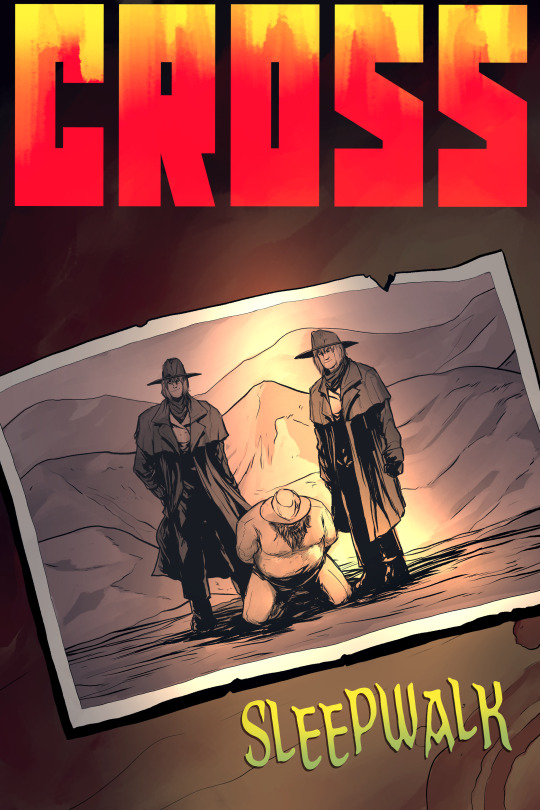
Many villages lined the Black Road, but much are alike in both design and reason for why they exist. Centuries of colonization, and Aurora is still untapped of what it could offer. Humanity has barely scratched a percentage of the planet, on account of both the world’s vicious sand storms and unforgiving climate. In addition, the natives practically own the mountains, and aren’t at all welcoming of humans digging too deep into their homes. Yet to this day people continue to stake their claims, coming to Aurora to find whatever section of rock or dirt that’ll hopefully grant them riches - ranging from lost Old Earth salvage, Deltan artifacts, or rich metals. When the dream dies, they settle down and try to make their fortune in another way: by settling a town.
When you travel the Road, you’ll find plenty of towns - some thriving, others dying, and many others to be completely abandoned. Often times these towns are a farm of sorts, others act as mines, and the rest offer some sort of service to travelers. You’ll have places built around a cookery, a goods store, churches, or - most commonly - a bar. When you’re living on a place like Aurora, you’ll always need a place to relax and have yourself a drink.
Jason had gotten a bad rep in a lot of the better spots along the Road. When you’ve got a habit of hunting your bounty into the one place everyone takes restage at, you tend to cause a fight or two. It doesn’t help that there’s sort of an unwritten law, that a bar is the most neutral spot you can find. So naturally, Jason had to drive for a long stretch of the road after dumping Sid’s body, all to find one bar to rest himself in. The one bar he could find a good change of getting a break was further south, in a town east off the Black Road and nearer towards Moresatta than Calberi:
A quiet little place called “Blondie”.
Population: about 48 people. Mostly men, with some women, children, and a few elderly.
It was a mining town that then turned into a wet stop for any traveling drunkard looking to stretch their legs before making the long trek for the city at the South end. From what Jason could remember off hearsay, it used to be quite the popular spot before a more easily reachable settlement was made, and the mines hit an impassable blockage that essentially killed the mining work there. It was named by its founder, for reasons that weren’t explained - save for the rare comment about an ‘inspiration’ of sorts. Besides the bar, a barber, and an alright tortilla shop, there wasn’t much else to get out of the place.
Jason met some regulars to the spot in his travelers, and they all described the bar’s selection of ales to be alright. There wasn’t anything better for miles on end - Jason couldn’t care less for quality at this point.
It took another 20 or so minutes before he would see the town coming over a hill, with a few lights twinkling to signal that any life was there. The wide swerve off the Road was rough, but after driving through some bumpy terrain he slowly came to what he assumed was the saloon. With the night still dark, and his moon dour, Jason didn’t pay much attention to the layout of the town - very few lights were set up in the town, and all Jason could care to pay mind to was where bar stood.
He slowly walked out the car and towards the large structure that acted as the town’s north-most landmark, and from a quick glance of the many lights and the muffled sound of music, he knew this was the bar. Jason made his way for the backdoor, and from the moment he steps in… he feels an all too familiar pain in his head.
Then he remembered.
Blondie was a town that greatly enjoyed the age of the Wild West from the Old Earth, from calling its bar a saloon to the style structure they built, along with all the stuff they hung on the walls of this very establishment. The place was at once a bar and a place of worship of the old. You saw posters that worshiped the heroes back in those days: legends like Wyatt Earp; Billy the Kid; and even good ol’ Harmonica. There were replica bull skulls, a set of guitars and tapestry. A table at a far off corner had a neatly made model of what those western towns looked like back in the day - all too similar to how Blondie is built, now that Jason thought about it. There were even the guns hanging around the place. Fake, of course -bought replicas from an artist, most likely.
Jason looked at it all. He observed the place, and wished even more he was elsewhere.
A music player was nestled by the hallway leading from the main bar floor to the back where Jason had entered. He have a look to see what was playing: an instrumental little thing called “Sleepwalk”. Santo & Johnny. Jason felt in a similar mood.
Then. “Jason?” He heard.
“Jason!” He heard again. “Jason, is that you?” Shouted a patron within the bar. Glancing from where he stood, Jason looked down the hall and saw a friend of his: a man by the name of Frankie Houser, seated next to a guy utterly new to this place.
Frankie was a tall, lean twig of a man at 6 feet in height. Atop his head was a set of red curls that looked like a broccoli had sprouted from his dome. His teeth angled forward whenever he spoke, and the apple in his neck stuck out for all to see. Though he made it all work with what Jason could best describe as the most honest and happiest of smiles. He wore a set of layered leggings that seemed to weigh him down, along with suspenders that hung over his gray-colored wife-beater. His boots were long and brown, almost turning red from the sand. Frankie kept a side-arm, a typical handgun, hanging off a holster to his side that kept him safe for his travels.
Beside him (on Frankie’s left) was another fellow, a curious one from appearance alone. A short, young-looking man that sat proper, unlike Frankie’s more laid back position. He was the cleanest thing in this entire bar, with a nice dark blue-colored suit that was one size too big on him - all over a light blue dress shirt with an obnoxiously green tie. He had dark brown skin, and short layer of black hair on his head, with none over his face. No dirt covered him, and no weapon was visible. Nothing except a backpack held tightly against his chest, only let go briefly so he may wave at Jason. A strange thing to see out here in some bar, Jason thought.
Making his way over, Jason took a seat beside Frankie’s right - all the while giving both men a handshake along the way. Frankie was firm and energetic, meanwhile the kid was weak-wristed but polite. Jason winced on the former more so the latter. With Jason seated, he looked to a bartender that had been waiting nearby - a grizzled, old looking man who gave a little nod to the new patron.
Jason placed his order: a glass of mildly sweet Deltan Ale, a straw, and a plate of ice.
Frankie turned to Jason, “Nice to see you, man. How’s like treatin’ ya?” He asked, with as much kindness and genuine interest. It was about the nicest thing thrown at Jason’s way today.
“Well”. Jason tsked, “Ain’t exactly going my way.”
“That about the truth for all of us, ain’t it?” Frankie responds. “Seems like nothing ever goes our way. Still, I’m sure you’ll find some good coming over yours. Just need to keep ya’ chin up.” He takes a pause to sip from his own drink - a glass of water, one for him and a similar for the friend beside him. It was then that he coughed a bit. All of a sudden a thought entered his mind and he swallows up his water before resuming his talk with Jason.
“Oh, almost forgot - rude of me. Jason, allow me to introduce to a new man here in the wastes. Kid’s name is Charlie. Charlie Wills. Landed onto Aurora, straight from Tyrell.”
Jason chuckled harshly, “Seriously? Tyrell? THE city, Tyrell?”
Charlie nodded before speaking gently. “That I am.”
With more a chuckling escaping from him, Jason then asked further of the young man, “What the heck are ya doing out here in the Black Road? Shouldn’t you be heading on over to Moresatta or something?”
With a slight hesitancy, Charlie’s response was interrupted by Frankie’s own explanation, “Actually, he’s taking the scenic route. We’ve been passing by every site we can find along the way. The kid’s loving all the villages we’ve come to visit so far - along with all the many delicacies they come to offer. Quarter of the trip’s spent trying out foods, I tell ya! Had in me now more than I have the past week!.” He lets out a long breathy laugh at that, bringing Charlie a clear look of embarrassment.
“Hilarious.” Jason comments, a tad positively at first but becomes more serious when he speaks to Charlie. “Hey, kid? Try not to waste too much time on the Black Road though. Drivers like Frankie here can’t be spending all night on the Road.”
“He’s alright, Jason!” Frankie exclaims, once more interrupting whatever reply Charlie was about to make. Frankie then continues, “He’s paying for my troubles, for starters. Plus, I’m having the time of my life. I get some moments to stretch my legs more than I would a straight drive anyhow.”
Charlie finally gets a word in, explaining that, “I’m doing my best not to take advantage of Mr. Hosier. Forgive me if I can’t help myself to stop so much, but you have a wonderful place here. Tyrell’s lovely, but Aurora certainly captures my interest far more by a great margin. Mr. Hosier here has been a great driver since he picked me up from Calberi, and all the sights I’ve seen have already made the expenses worth it. I must say, you have a beautiful world here, sir.”
“Yeah, well so is a lady with experience.” Jason remarked with a lazy grin. “Pretty to look at, but mess with her and she’s already got a knife aimed for your throat.”
Frankie stifles a chuckle, but Jason continues - again, seriously. “Listen, kid, do yourself a favor- go back home. Aside from the two cities, there ain’t nothing to see here on Aurora. It’s a wasteland, empty except for a bunch of folks killing each other all the damn time, and a lot of gangs playing dress up while proving to see who can shoot each other more.”
“Well I’m sorry to say, but t-that’s precisely why I came.” Charlie nervously shoots back, proceeding to open up his backpack and dig right in. “I’ve got - if you let me a moment - some things I wanted to see here that you don’t get in other worlds. All we ever hear about Aurora are the gangs, he natives, and the various wars. So much history bottled up in this one planet, it’s all so interesting yet nothing I’ve read at home really do it justice. Tyrell barely gets anything, and oftentimes what we do get is questionable in its legitimacy. I had to come here, to confirm it myself that it’s all true.”
He keeps on digging, prompting Jason and Frankie to side-eye each other with looks that equally find entertainment at Charlie’s naivety. They don’t say anything, however they’re somewhat intrigued by what the young man’s looking for. Eventually, Charlie produces a thick black binder. He opens it up, revealing a colorful collection of prints and photographs - to which the two natives of the planet take a gander.
Charlie flips past the first couple of pages to show off a small selection of printed replicas of old war-time posters - from the era of conflicts happening on Aurora. They depicted humans in UROE infantry gear, either lining up in inspirational formations or firing their rifles at sword-wielding giants. He turned a page, briefly pausing to let them examine each photo before continuing on to the next. The next set featured prints of a different tone: humans, holding their hands up in union with the giants, set against amber colored mountains. Additionally there were prints which shows 5 humans and one giant, all working at a construction site with words emphasizing “union” and “working to the future”. From how each print looked, it seemed that the original posters were painted before being copied for mass distribution - with a warm, inviting feeling that nostalgia-lovers would love to get their hands on.
Eventually Charlie did some commentary as he showed off the prints - a bit of confidence making its way up the surface. “Check it out. War propaganda from around the Great Aurora War, nearly a millennium ago. Back then we didn’t know whether to trust the natives or to present them as enemies, so marketing sorta changed in those years. All of it made from a printing company in Aurora, who only got a brief clue of what Deltans looked like from news and word-of-mouth.”
He turned another page, commenting further, “Then see here: prints of the continued war with the Kronian Empire.” The young man, smiling at the two men looking down at his book, turns the page to showcase further pieces in his collection. He pointed to various prints, all of them depicting red-eyed figures, either in pale white face or under black gas-masks. There was one print in particular he directed to the most, where it featured a looming, red-eyed gas-mask wearing creature leering deviously over a group of human colonists. It displayed the text: “OUR HOMES ARE IN DANGER”
Page after page he turned, with Charlie showing off more of his historical collection. Jason was honestly interested at this point, especially when he noticed that none of it remotely mentioned the Old Earth. There were so many detailed, organized prints of Aurora history - even stuff he never heard about.
Charlie’s commentary drew Jason away from his initial cynicism - made all the better as Charlie came out of his shell and was eager to share history with a couple of locals. Though it also helped that, by the time he was listening, Jason’s plate of ice and drink had arrived. The kid kept on talking, being so open and smooth in his vocals, with all the nervousness having gone away.
He’d say this like, “This is a photo of several Deltan natives making the first trek down the Black Road; you may notice how some look uncomfortable with the surface at first.”
Or, “A print showcasing the opening of Moresatta. I managed to get this printed straight off the archives back home - it was so exciting.” He was quite captivating when was in the zone.
Frankie, out of them all, was the most absorbed into it. In between his listenings and close examinations, he’d make the passing comment of “been there” and “seen that”. Every now and then he’d even correct Charlie on something, like how the Deltans rarely fought each other in colonized lands - prompting Charlie to grab a napkin and write the info down with a pen kept in his pocket. Of course there was a disappointment in Charlie: it scratched off the goal of seeing two Deltans fighting, as he heard from the stories.
By the 30th page however, it got too personal for Jason. As they closed halfway upon the hour, Charlie began turning the pages towards more recent history - and Jason felt less enthused.
Every page was a painful memory for Jason, and especially the world.
The mass incarceration site built in off the Road to house countless numbers of UROE prisoners, only to lead into a jailbreak many years back. With it brought the near endless supply of raiders and bandits that roam the Black Road, causing so much trouble from that catastrophe.
The crackdown by the UROE, which began with arming various militia groups to fight back the raider scourge. All that did was lead to even more violence along the Road.
The deadly raid on the Black Road hospital up North, leading to dozens dead. Nobody had a chance there.
Everything that came in before or during his childhood, and yet still messing up his life to this day.
Then the photo that Jason hoped wouldn’t come… finally arrived.
Charlie turns the page, explaining at first, “Of course there were many people we saw fighting the raiders in the vids that aired in Tyrell. They were probably the most popular ones when you consider the views they got. It was a group of these cowboys, dressed up like in the Wild West - calling themselves the Crimson Crosses. See, I even got a photo of two such members right--”
He stopped right there, almost completely. Charlie took notice first of Frankie’s slight cringe, before then directing his sight at Jason.
Charlie had seen this photo about a dozen times, but a new detail emerged then. The photo showed two young men, both wearing a set of wild-west inspired outfits over their tall, powerful frames. The garments consisted of brown vests; long-sleeve collared shirts, dull dark pants, and a dark overcoat covering much of it. Atop their heads were similarly sized wide-brim hats, and around their necks a bandanna. As well, both men shared the exact same style of hair, and exact appearance of face. Between them was an overweight, gruff-looking bandit tied up with a lasso, with both men posing triumphantly beside him.
Below the photo, on a sticker Charlie used to caption his photos, it read, “The Cross Twins, Frederick and Jason, capture the Butcher of Red Peaks.”
Jason hesitantly grabs the photo - his mind felt like it was screaming ‘no’, but a part of him felt like he needed to see it. He brought it closer and looked down at the picture, and at that moment all the color and life in his face drained completely - and in its place, a flood of bad memories once walled up behind years of alcohol.
Meanwhile Charlie looked towards the stranger, studying his face in relation to the photograph. There he was: Jason Cross of the Crimson Crosses - older, stronger…
And now he’s downing an entire glass of ale.
#KRONOS#CROSS#my writing#eyeofsemicolon#the5thsemicolon#semicolonthefifth#story#western#science fiction
3 notes
·
View notes
Photo

#broccoli city founder#brandon mceachern broccoli city#brandon mceachern#brandon mceachern marcus allen#marcus allen broccoli city#bc#broccoli city nike#broccoli city festival#bcfestdc#broccoli city tee
0 notes
Text
Lee Daniels, Erika Alexander & More Attend Theatre Leadership Project Celebration

The Theatre Leadership Project was created during the pandemic to make changes in the theatre world by installing BIPOC leadership in the industry. The group had its first in-person event Monday, October 24th at the Brooklyn Chop House in New York City's Times Square. Actress Erika Alexander and film producer Lee Daniels were amongst a group of attendees that included Fellows; Founders; Advisory Council members, including Aalithya Stevens and Olivier Sultan; funders Darren Johnston, Dessie Moynihan and Robert E. Wankel; and Warren Adams and Orin Wolf from TTLP partners Black Theatre Coalition (BTC) and The Prince Fellowship Director.
Barbara Broccoli, Alecia Parker, Patrick Daly and Travis LeMont Ballenger established TTLP in 2020 and they have raised more than $1 million to support their fellows and placed six in Broadway general management firms for training in general management and company management. Fellows have worked on Broadway shows including To Kill A Mockingbird, Kinky Boots, Macbeth and Some Like It Hot.
“The work of building a more welcoming, inclusive and fair industry doesn't happen alone. We are in need of community to sustain the change we seek to make, so we are fortunate to be doing this work hand in hand with partners who are dedicated to long term change,” said TTLP Program Manager Leah Harris. “We are proud of the work our fellows are accomplishing and are eager to continue following and supporting their success.”
TTLP is currently raising money for the addition of a stage management program. For more information check out their official website.



0 notes
Link
Over the summer, we began to see society get back to pre-pandemic times, some of our favorite events and festivals making a return! As Black people navigate returning to some sort of normalcy, we’re always on the look out for ways to celebrate Black joy. What better way to do that than attending a festival? We can gather, celebrate Black culture, and be unapologetically ourselves. There’s all types of events that we hope to attend locally or nationwide each year, such as Pittsburgh’s Soulful Taste that’s meant to celebrate local Black food eateries, or Pharrell’s Something In The Water (SITW) music festival. Here’s seven other Black festivals you should attend at least once, courtesy of Melanin Is Life: Broccoli City Festival: Washington, D.C’s own Broccoli City Festival was started in 2013 by four friends who wanted to positively impact their community. Through music and food, they aim to spread awareness on environmental justice and sustainability, economic sustainability, culture, access to quality food and shelter, and education in underserved communities. They also saw the festival as just a fun way to bring attention to Earth Day! After two years of COVID-19 cancellations, the concert that draws in thousands of people made a return this past May with a lineup that included Ari Lennox, Masego, Wale, Tems, and more. Other events are hosted throughout the weekend, such as a city 5K marathon...
0 notes
Text
Grewfarm: producing vegetables and electricity in a short circuit
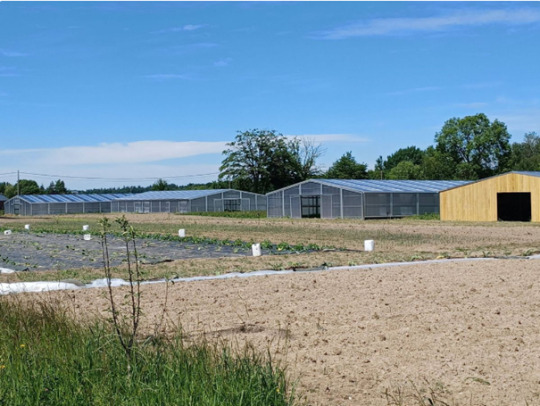
In Chimay, agrivoltaic greenhouses operated by a young vegetable gardener will directly meet the needs of the neighbouring inn. The Grewfarm project hopes to spread to Wallonia.
Combine production and consumption in a short circuit, both in terms of food and energy. Born in the mind of Vincent Vanderveken, this idea recently became reality with the inauguration of the Grewfarm[1] project in the Chimay region.
"The idea came to me because I was accompanying vegetable gardeners to whom I was giving training in circular economy, comments the latter who defines himself as a consultant-entrepreneur in the field of energy transition. They were all very motivated, then we realised that many gave up over the months because it is very hard work, with very heavy hours to end up earning a meager 6 to 7 euros per hour."
Also founder of the Green City Wallonia[2] cooperative[3], specialising in the development of renewable energy production facilities, Vincent Vanderveken then thought that it should be possible to improve the working conditions and incomes of vegetable gardeners by combining their activities with photovoltaic electricity production infrastructures.
Designed in partnership with architects, a landscape design office and the company Green Energy 4 seasons[4], a first series of pilot agrivoltaic greenhouses have just been installed on a plot of land made available by the Chimay Foundation[5], that borders the 'Auberge du Poteaupré[6]. Popular with tourists and organisers of seminars, this hotel-restaurant is also backed by a space that promotes the Trappist beers of Chimay and other local products.
Placed on a metal frame, the roof of the greenhouses alternates rows of polycarbonate panels and rows of solar panels. Light and resistant, the first named allow the light essential for plant growth to pass through, while the second provide welcome shade that prevents crops from “burning” in periods of too much sunshine, while producing electricity.

In total, these 1,500 m² of greenhouses will make it possible to grow various seasonal vegetables -sometimes forgotten- organically, while alongside them an additional 10,000 m² are also available for outdoor crops.
Push self-consumption to the maximum
"The produced electricity will directly supply the Auberge de Poteaupré. It will be self-consumed up to 80% on the site, the objective being to aim for 100% in the long term, explains our interlocutor. A small fraction of this production is used to make operate the pump that irrigates crops; it can also be used to power LED lights that will promote plant growth, manage ventilation or heat greenhouses using a heat pump in between seasons. In this way, the vegetable gardener will be able to start his season a little earlier by producing his own seedlings and finish it a little later. The aim is to enable him to improve his income while reducing his costs. In partnership with ULiège[7], UMons[8] and the Haute Ecole Condorcet[9], we have entered a file within the framework of the competitiveness clusters of the Marshall plan[10] to develop equipment that would make it possible to optimise and automate the implementation of these systems in order to make life easier for the vegetable gardener by achieving the best cost-benefit ratio."
A research program which will also aim to reduce the costs of this type of equipment in order to facilitate their distribution on a larger scale, underlines Vincent Vanderveken.
High-tech and animal traction
At the beginning of June, several rows of cabbage and broccoli are neatly lined up in one of the three greenhouses. " They pushed too high because they were planted when it was very hot and very dry, and the irrigation system was not yet operational", comments Jean Yernaux, the director of the Auberge de Poteaupré - Espace Chimay .
The site now has a 300 m³ basin in which the rainwater collected from the roofs of the greenhouses and storage sheds is stored. A tank that is also connected to a nearby well, which will make it possible to top up if necessary in times of drought.
A few steps away, two donkeys are snorting on a piece of pasture adjacent to their comfortable shelter. These are the two "tractors" of Corenthin Rouneau, the young vegetable gardener who was chosen to operate the site after a call for applications. "He is a bioengineer. He uses animal traction firstly because he is convinced by this technique and then because the donkeys enable him to circulate much more easily between the supporting structures of the greenhouses than with a mechanical machine. "
Jean Yernaux does not hide his enthusiasm for this project that, in his eyes, takes the short circuit to its "climax”. "With the chef, we rewrote our menu in terms of hot and cold vegetable accompaniments so as to adapt to what the vegetable gardener told us he could produce both in terms of varieties and respect for the seasons. On our side, we gave him forecasts on the quantities to be produced based on our average consumption. The objective is to put on our plates 80 to 90% of what he will produce in the greenhouses and on the outdoors plots that are located a few tens of meters from the restaurant.”
A predictability which will bring a certain financial guarantee to the young independent market gardener, who also operates another plot of one and a half hectares. "We are going to absorb a large quantity of the vegetables he produces. He will be able to use the surplus and continue to cultivate for his private customers and the cooperatives he supplies", observes our guide.
The other advantage of this formula, continues Mr. Yernaut, is that it makes it possible to optimise the use of the electricity produced by the photovoltaic panels. "The system has been sized to promote self-consumption as much as possible, based on the fact that the peak of photovoltaic production generally corresponds to our peak of consumption in spring and summer. When the weather is nice, we receive a lot of visitors and the kitchens are running at full speed." Visitors – the Auberge welcomes approximately 150,000 customers each year – who will therefore taste organic and local vegetables prepared using electricity also produced locally.
It is also "good for our brand image", recognizes the boss of Poteaupré. "It is clear that we will communicate on this during the high season. But this project is not greenwashing, it is above all a beautiful project because it really makes sense."
A project per Walloon municipality ?
Such an infrastructure represents a substantial investment – around 300,000 euros for this pilot project – which is obviously not within the reach of a market gardener.
"The idea is to create a somewhat atypical model that associates a third-party investor[11], who is reimbursed with the sale of electricity and green certificates[12]. After 10 to 15 years, he has amortised his investment and benefits from a return on an installation which has a lifespan of around thirty years, explains Vincent Vanderveken, adding that one can also imagine using crowdfunding or private savings".
In Wallonia, municipalities, CPAS[13], church factories[14] and other landowners have plenty of land that could accommodate an infrastructure of this nature. "And these could directly supply fresh vegetables to a hospital, a nursing home, CPAS beneficiaries or even local restaurants", while allowing vegetable gardeners to have a tool that strengthens the viability of their activities and improves their working conditions, he develops in stride.
The designers of the project, meanwhile, plan to create an industrial player capable of manufacturing, delivering and assembling these "kits" of installations, already used in France and Spain, for which demand is growing strongly in Europe. "We hear everywhere that we need to reindustrialise Wallonia, that's very good. But we have to be aware that we will no longer make steelworks. We have to build the industries of tomorrow and this project seems to us reconcile the objectives of autonomy, as well as food and energy relocation that we must pursue."
Source
Gilles Toussaint, Grewfarm : produire des légumes et de l’électricité en circuit court, in : LLB, 27-06-2022, https://www.lalibre.be/planete/inspire/2022/06/27/grewfarm-produire-des-legumes-et-de-lelectricite-en-circuit-court-6TSACHXDZBCN7KTJKX7PU2F37M/?fbclid=IwAR0ixLpwenQtX4vwHvHcz4e5avKPjkqUkmYpbmEY1j5gi6SdyNlJzl_a0ds
[1] The consortium of this project, made up of Green Energy 4 Seasons, DHK, UMons, HEPH-Condorcet and ULiège, is studying the creation of a range of agrivoltaic greenhouses, optimized and equipped with auxiliaries (accessories), in order to facilitate the work of the market gardener and to optimize his productions. https://www.wagralim.be/nos-projets-innovation/grewfarm/
[2] Wallonia is one of the three regions of Belgium—along with Flanders and Brussels. Covering the southern portion of the country, Wallonia is primarily French-speaking, and accounts for 55% of Belgium's territory, but only a third of its population. The Walloon Region and the French Community of Belgium, which is the political entity responsible for matters related mainly to culture and education, are independent concepts, because the French Community of Belgium encompasses both Wallonia and the bilingual Brussels-Capital Region.
[3] Green City Wallonie SCRL is a cooperative society providing access to Renewable Energy systems for all. Created on the initiative of cooperators experienced in Renewable Energies and business management, Green City Wallonia brings together cooperators convinced that the future depends on local Renewable Energies and more biodiversity. https://greencitywallonie.be/index.php/qui-sommes-nous/
[4]Since 2008, the company Green Energy 4 Seasons has been entirely dedicated to the installation of photovoltaic panels to lead the group today to the first position of installers in the sector in the Walloon region. Our company is present in the province of Luxembourg, Hainaut, Namur, Liège and Brabant Wallon to guarantee the best service for your photovoltaic project. https://www.greenenergy4seasons.be/societe-photovoltaique/
[5] The Foundation was created on September 27, 1996, on the initiative of the Community of Cistercian monks of the Abbey of Scourmont. The Community then wishes to separate its monastic and economic activities. During all these years, accompanied by an independent jury made up of citizens, the Foundation has invested heavily in supporting projects submitted by young people, actors in the non-profit sector and entrepreneurs. The Foundation is gradually implementing its new vision and expanding its horizons. Some actions and calls for projects are now open to 13 municipalities in the south of Entre-Sambre-et-Meuse… https://www.chimaywartoise.be/a-propos-de-nous/notre-histoire/
[6] A stone's throw from the Notre-Dame de Scourmont Abbey, the Auberge de Poteaupré has been welcoming you for more than 100 years in a warm and rural atmosphere. The *** hotel offers 8 very comfortable rooms.https://reservation.elloha.com/?idPublication=008baeb4-f9ae-4286-a187-21708ae63ca0&idoi=a903f99f-b095-445f-af37-f238ced247bf&culture=fr-FR&searchFirstAvailableDates=1
[7] The University of Liège (French: Université de Liège), or ULiège, is a major public university of the French Community of Belgium based in Liège, Wallonia, Belgium. Its official language is French. As of 2020, ULiège is ranked in the 301–350 category worldwide according to Times Higher Education, 451st by QS World University Rankings, and between the 201th and 300th place by the Academic Ranking of World Universities. More than 2,000 people, including academics, scientists and technicians, are involved in research of a wide variety of subjects from basic research to applied research.
[8]The University of Mons (abbreviated as UMons) is a French-speaking university in Belgium located in Mons, capital of the province of Hainaut, near the Franco-Belgian border..
[9] The Provincial University College of Hainaut Condorcet (HEPH Condorcet) is an official University College whose Organizing Power is the Province of Hainaut. This institution is the result of the merger in September 2009 of the three provincial Hautes Écoles located in Hainaut. The HEPH Condorcet offers around fifty short-type (bachelor's) and long-type (master's) courses, as well as specializations and bridges.
[10]The Walloon Government adopted the text of the "Marshall Plan 2022" in December 2013 at second reading. , future challenges and implications of state reform. The 2022 Marshall Plan paves the way for Wallonia to be able to meet the challenges it faces, in terms of competitiveness, environmental and budgetary sustainability, in terms of demographics and health, as well as in connection with transfers of skills. https://economie.wallonie.be/content/plan-marshall-2022
[11] Green City Wallonia in this case see note 3
[12] A green certificate are a tradable commodity proving that certain electricity is generated using renewable energy sources. Typically one certificate represents the generation of one Megawatthour of electricity. What is defined as "renewable" varies from certificate trading scheme to trading scheme. Green certificates represent the environmental value of renewable energy generated. The certificates can be traded separately from the energy produced. Several countries use green certificates as a means to make the support of green electricity generation closer to a market economy instead of more bureaucratic investment support and feed-in tariffs. Such national trading schemes are in use in e.g. Poland, Sweden, the UK, Italy, Belgium (Wallonia and Flanders), and some US states.
[13] The CPAS (Public Centre for Social Welfare) is a public institution that exists in each of the 581 municipalities of Belgium. Every citizen of Belgium has the right to social assistance and social integration. The term is a translation of the Dutch Openbaar centrum voor maatschappelijk welzijn (OCMW), French Centre public d'action sociale (CPAS) and German Öffentliches Sozialhilfezentrum (ÖSHZ).
[14] A church factory is a public institution that manages the material resources necessary for the exercise of worship in a parish. Such institutions are found in Belgium, Luxembourg, Italy and certain regions of France.
1 note
·
View note
Text
NORTH DAKOTA
28 Aug 2018 (Tue) – We made sandwiches, packed a cooler, and took off for Theodore Roosevelt National Park today. Unfortunately, the weather was drizzly and overcast all day. That limited visibility of the surrounding area. Since this is our last day in the area, we just had to deal with it.
We drove along the loop road, stopping at pullouts to see what we could see. We hiked two trails then sat at an overlook and enjoyed lunch while the rain picked up a bit. During our drive we spotted pronghorn, three different herds of bison, several prairie dog towns, Nokotas (wild horses), and an elk. When we emerged from the park, we fueled the truck and returned to the campground.
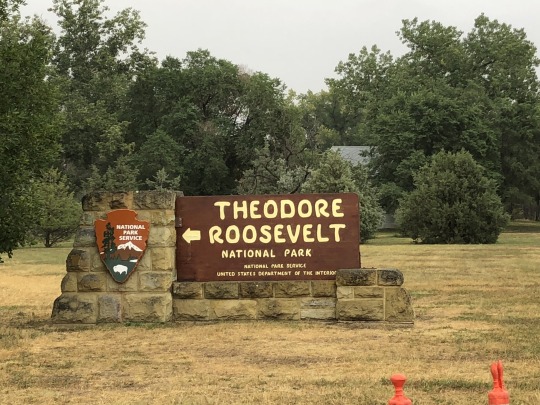
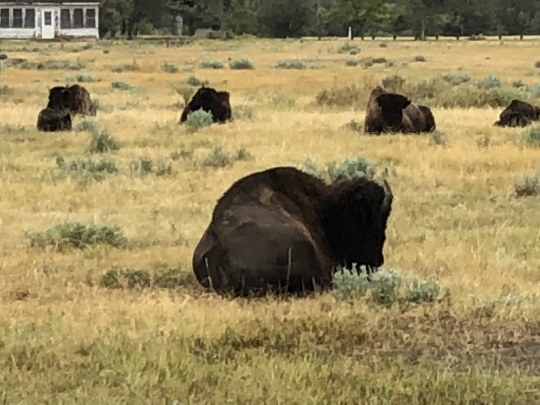


27 Aug 2018 (Mon) – It was cool, rainy, and overcast all day. We decided to keep our activities indoors. First stop was at Theodore’s Dining Room in the local hotel. It was a breakfast buffet with very good food. There were four kinds of eggs (one had crab), bacon, sausage, hash browns, waffles, and granola with fruit. It was a little expensive but very enjoyable.

After breakfast, we walked around town a little then toured the Cowboy Hall of Fame. There were all kinds of stories of horses, cowboys, ranches, and competitions. Videos recounted stories of experiences by early settlers and their descendants. After the museum, we walked along the main street. Harold Schafer came to this town in the early-1960s and restored much of the town of Medora. He renovated/rebuilt many of the buildings in town and bought the existing amphitheater. He updated the seating and property, and brought a new, flashier show to the outdoor stage. Medora sits at the entrance to Theodore Roosevelt National Park and Harold envisioned a popular tourist town that people would want to visit and stay at.
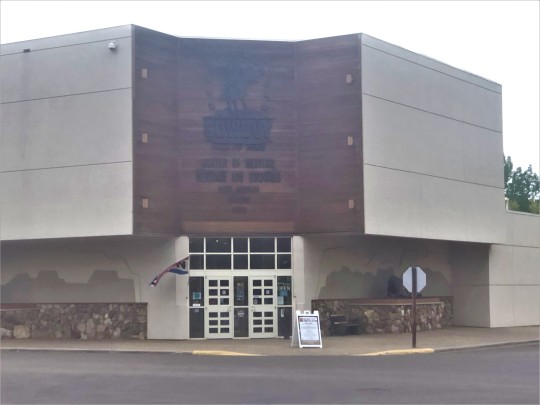
Medora’s claim to fame is that Theodore Roosevelt came here back in the late-1800s. He fell in love with the place and bought two cattle ranches. They say he claimed that the time he spent in the Badlands of North Dakota prepared him for his role as president. His nickname was Old Four Eyes. He was disturbed about overhunting of wildlife on the range and the rapidly disappearing buffalo. Roosevelt wanted future generations to be able to enjoy the Wild West that he knew and loved. As President of the U.S., he was first to set aside national parkland. During his presidency, he preserved millions of acres of land, thereby ensuring that future generations would be able to enjoy the wonders of nature and the wildlife that inhabits it.
We drove to the Marquis de Homes, the home of the founder of Medora. He and his wife traveled from France. The Marquis was enamored by the stories of the Wild West and he wanted to be a cattle rancher. He came here, established a cattle ranch and meat packing plant, and named the town after his wife. His idea was to raise and slaughter cattle at one place, then ship the meat back east. It turned out to be more profitable than driving cattle hundreds of miles.

We drove into Theodore Roosevelt National Park to the visitor’s center. We wanted to get some information about hiking trails and the scenic drive. Hopefully, the weather will be more pleasant tomorrow and we can explore the park.
Last stop was at a local convenience store (the nearest grocery store is 35 miles away) to pick up some groceries. They didn’t have much so we only picked up water and lunch meat.
26 Aug 2018 (Sun) – We packed up and left Bismarck at 10:30 a.m. It was a short hour and a half to our next campground. About three fourths of the way here, we stopped at a visitor’s center called Painted Canyon. What an amazing change of scenery! Behind the center was a landscape of ravines and hills with remarkable colors. We were driving along looking at flat farm land with wheat fields and sunflower crops. This was quite a change in geography. Usually these things change slowly but this was a rapid change. After we left the center, the landscape quickly morphed into colorful hills and canyons.
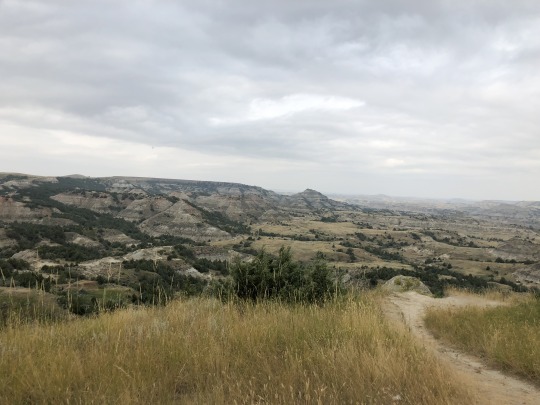
We pulled into Medora Campground around noon. It is a large campground with red dirt roads and campsites. There are some trees to provide shade. The sites are close and the neighbor’s sewer hookup is right outside our door. They could have laid the campground out better.
As soon as we were set up, we did the laundry. The laundry room was a pretty good size with six washers and four dryers. No one else was in there so we were able to use three washers.
At 5:00 p.m. we drove to the Pitchfork Steak Fondue across the road. We had called and made reservations the day before yesterday. When we walked into the dining area, we saw dozens of picnic tables. They could probably seat 2,000 people. There were pitchforks with steaks already impaled and waiting to be cooked. There was also a large buffet area for the sides that were being served with the steaks. We got wine at a small stand, claimed our table, and waited for the meal to start. There was a small 4-person band playing country music in the center of the pavilion. When the word went out that it was time to eat, everyone lined up. We got a stamp on our hand but never had to use it so I’m not sure why we got it. The buffet included a baked potato, baked beans, Texas toast, cole slaw, broccoli & cauliflower, carrots, tomatoes, and ranch dressing. After loading up on sides, we walked over to the cook area and got our steak. There were probably a quarter of the people they would usually have on a holiday weekend. Lots of tables were empty or had only one or two couples at them.

At 6:30 p.m. everyone moved over to the outdoor amphitheater. It was a huge seating area cut right into the side of the mountain. The stage had tracks that allowed the scenery to slide sideways and the band stand to slide forward. The show was every bit as good as Opryland. It was very professional and the singers and dancers were very talented. There were two co-hosts – Cowboy Chet Wollan and Bill Sorensen. Wollan sang and danced right along with the accompanying performers. The comic, Kermit Apio (from Hawaii), was hysterical. I never laughed so hard at a comedian before. The weather was a little cool. As the sun set, the temperature dropped and many people had blankets they had brought. We wore jackets but would have appreciated a blanket ourselves. The show ran from 7:30 to 10:00 p.m.

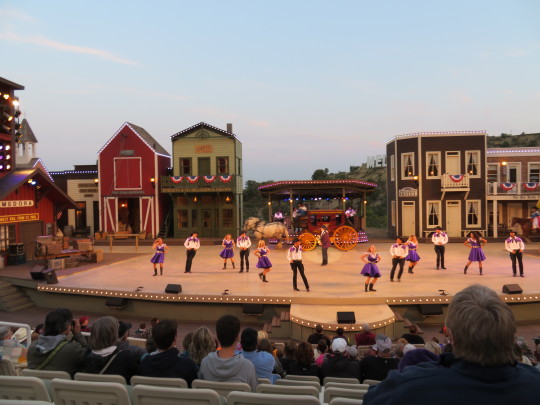
25 Aug 2018 (Sat) – We went to Fort Abraham Lincoln today. The Custer House was a recreation of the house General Custer and his wife lived in but all the furnishings and clothing belonged either to them or from that time period (1870s). The CCC built several buildings on the former compound grounds. There was a large granary, a barracks with mess hall, a stable, and a commissary that had a snack bar, library, gift shop, and restrooms. We had a hot dog for lunch. I’m not really sure what it was we ate. The dogs they gave us were red. They put some kind of dye in them. I was afraid they were soy dogs. We just ate them. We then drove to the visitors center where they had a replica of the Slant Indian Village. There were six earth lodges. They were full size mounds made from logs, branches, and dirt. They were circular in design and had a fire pit in the center of the lodge with an opening in the roof.

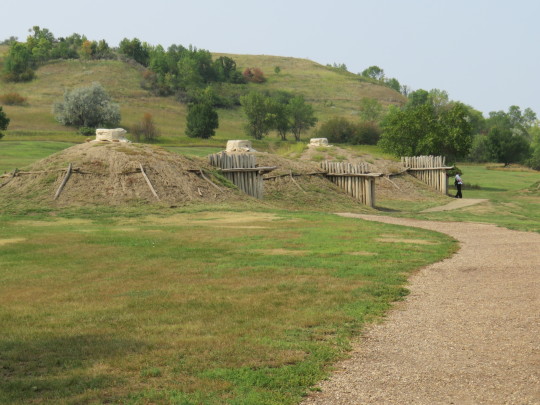
It rained again last night but there was (thankfully) no thunder and lightning. I don’t know why it seems to only rain at night here.
24 Aug 2018 (Fri) – The most ferocious thunderstorm rolled through during the night. The first boom literally lifted me out of the bed. I have never experienced a storm like that one. There was no wind and very little rain but there was lots of lightning. So much that it was like daylight. The thunder was explosive and had a concussive effect. The thunder rumbled for close to a minute. The storm was both exhilarating and frightening.
We went to breakfast at Ramkota Hotel in their Seasons Café. The food was very good and the ambiance was very attractive. They definitely like dark wood. We then went to the Dakota Heritage Center right next to the capitol building. It had a lot of interesting displays, artifacts, and exhibits but it was laid out in a very confusing way. We left the center and drove to Longhorn Steakhouse for lunch. Then we stopped in at Captain Jack’s to pick up some wine and at Target to get groceries. We ran out of rice for Bonnie and were giving her dry dog food with her boiled chicken. Unfortunately, she got diarrhea so we need to put her back on the rice. She has developed a really sensitive stomach.

After dinner, we worked on the mapping the route for our Utah caravan next year.
23 Aug 2018 (Thu) – We left Garrison around 10:30 a.m. There were a few sprinkles on the way but the weather was basically clear. In an hour and a half, we arrived at General Sibley Park & Campground in Bismarck. This is a great campground! The campsites are very roomy but only have electric hookup. We had to stop on the way in to fill our tank with fresh water. There are many trees in the campground but all the underbrush has been cut away and the grass mowed so everything looks open.
After set up, we drove into the city and took a tour of the capitol building. It has a two story building with an 18-story tower added on. We met the tour guide in the lobby and joined two other couples for a tour of the building. She took us first to the original part. It was like walking into the land of Oz. The hallway ceiling was 40’ and set in an art deco style. We looked into the Senate and the House chambers. They only meet every other year so they vote in a two-year budget. How do they legislate an entire state if they only meet bi-annually?

Next was a ride up to the 17th floor to the overview. We walked out on the deck and admired the view of the surrounding area. It seemed like you could see forever.
After the tour of the capitol, we took a tour of the former Governor’s Mansion. Then we went to lunch at the Blarney Stone Pub. I had Shepherd’s Pie and Paul had a pasta dish. Everything was very good. We then found a post office to mail off some post cards then returned to the campground.

22 Aug 2018 (Wed) – We drove around the area today. First stop was at the Custer Coal Mine. It was not owned by General George Custer. The placards at the area didn’t really explain why it got the name it did. It was a strip mining operation that mined coal. There was a small pond to look at.

We then drove to Fort Stevenson. One building was on site with display items telling the history of the fort. The actual fort is two miles northwest of the site under water. Nothing of the original fort remains. This was the last place General George Custer stayed before he rode off to the Battle of Little Bighorn.

After the fort, we drove around the state campground. They have over 100 campsites and only three campers. Apparently this is now their slow season. The campgrounds only fill up on the weekends. We guessed that is because North Dakota is so far north that many families cannot camp here and make it back home in time for school. As a matter of fact, the North Dakota state college classes started this week. Guess it’s the same across the country. K-12 usually starts the day after Labor Day.
Next, we drove into the town of Garrison. It was small but cute. After lunch at Ye Olde Malt Shoppe, we strolled up and down the main street. Lots of businesses called themselves Ye Olde ____. There was also a bottle shop. In this state, there are no liquor stores. They are called bottle shops. These shops are usually attached to a bar where liquor is served.

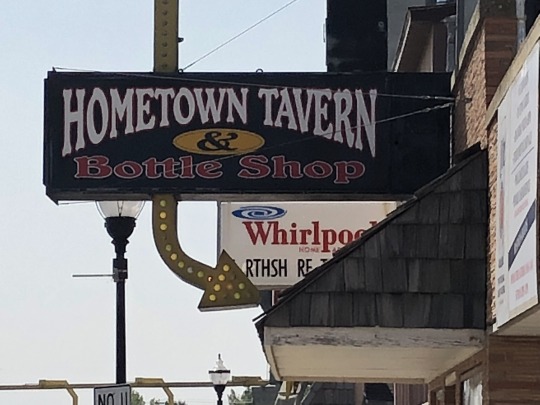
Last stop was at Krause’s Market. It was a small supermarket but we were able to pick up just about everything we needed. We came home and grilled corn on the cob. It was just like back home. The corn was delicious. Unfortunately, the flies are horrible. At they aren’t mosquitoes. After spending most of the meal swatting the flies away, we put a corn cob at the end of the table. The flies happily swarmed on it and mostly left us alone for the rest of the meal.
This has been such a lovely campground. The weather has been perfect. The haze from the fires out west were washed out by the last storm and we now have partly cloudy to clear skies. It’s been in the high 40s in the morning and in the high 70s to low 80s during the day. We can sit on the lake shore and watch the birds swimming in the water and the little chipmunk-like animals scramble among the rocks lining the shoreline.
21 Aug 2018 (Tue) – We packed up and left Minot AFB at 10:45 a.m. The weather was good and we arrived at our next stop in East Totten Trail Campground at 12:15 p.m. It is an Army Corps of Engineers site on Lake Audubon. This is one of the nicest campsites we have been in for a long time. We back up right on to the lake shore. The sites are spacious with plenty of room for the picnic table and barbecue.
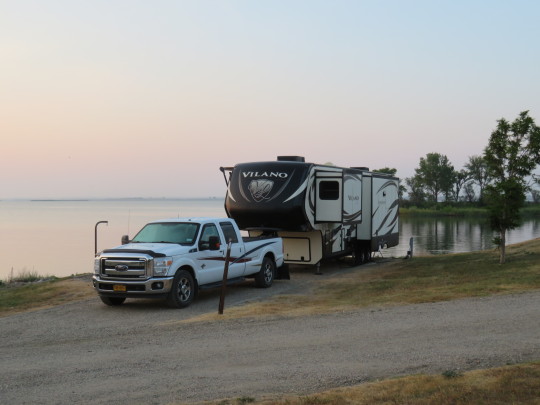
On the other side of the causeway is Lake Sakakawea (we pronounce it Sacajawea everywhere else). This is the third largest reservoir in the United States. Garrison Dam is the fifth largest earthen dam in the world. The lake is 178 miles long and 14 miles wide. The dam itself is two and half miles long and 210 feet high. We drove around the area looking at the dam and spillway. There is also the Audubon National Wildlife Refuge on the lake.

Next stop was at the Garrison Dam National Fish Hatchery. Unfortunately, we stopped there 15 minutes before the tank buildings were closing. We rushed through them to look at the fish. There were burbot, trout, paddlefish, and two kinds of sturgeon. The pallid sturgeon is on the brink of extinction. The only thing that has saved it is its longevity. When the dams were built on the Missouri River, it disrupted the spawning habits of the fish. It took 20 years to realize that the pallid sturgeon were dying off and another ten years to react and get a program in place. The fish live 80 to 100 years. They have to capture fish and take blood samples to find out their gender. The hatchery takes sperm from males and freezes it. When they get females, they get them to lay their eggs (spawn) and then use the sperm to fertilize the eggs. It sounds like such a complicated process. Only about 35% of the little fish released into the river survive.

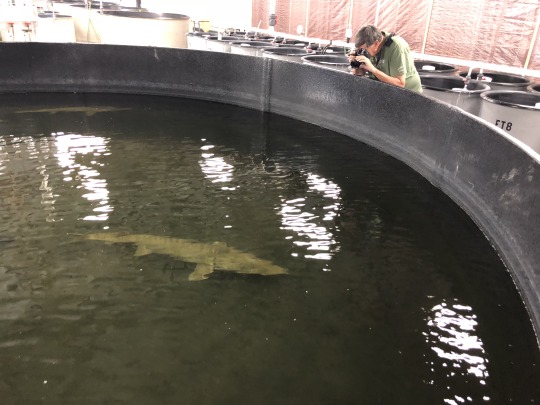
After looking in the tanks, we went back into the visitor’s center and spoke with the docents in the building. It turned out that they are volunteering to help out at the hatchery for the season as part of a workkamping program (many people do workkamping). The husband and wife were both retired servicemembers. We spoke about travelling around the U.S. and serving in the military.
When we left the hatchery, we drove into the nearby town of Coleharbor. It was very small and had no grocery store, no post office, no restaurants, no nothing. We then drove to the other side of the lake to the town of Riverside. It was basically the same thing – a small town with nothing. At the entrance to the campground, there is a service station and an eatery. We had dinner at the Totten Trail Bar & Grill.
Later, after we got back to the campground and spent an hour on the phone trying to get the Dish satellite working, we visited with the couple next to us. They started full timing a year ago. We exchanged stories of places to see and things to do.
20 Aug 2018 (Mon) – We drove to the Scandinavian Heritage Park this morning. It claims to be the only park in the world that represents all five Scandinavian/Nordic countries. There is a visitor’s center at the front of the park and a plaza with the flags of all five nations. All of them have the same design with different colors – a solid color background with a cross. Denmark is a white cross on a red field. Finland is a light blue cross on a white field. Iceland has a red flag bordered in white on a dark blue field. Norway’s flag is a blue cross bordered in white on a red background. And Sweden is a golden yellow cross on a light blue field. We wondered if all these countries were once a single nation before dividing into separate entities. Why do they all have the same design?
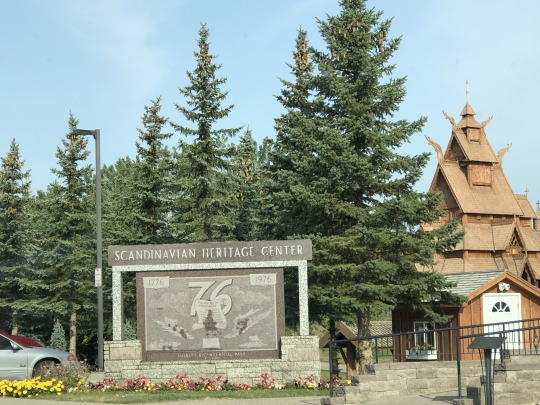
At any rate, there were several different items around the park depicting items from the Scandinavian countries: statues of Hans Christian Anderson, Sondre Norheim (the father of modern skiing), and Casper Oimoen (an Olympic skier); a 30-foot tall Dala horse (a Swedish symbol); replicas of the Gol Stave Church from Norway and a Stabbur (storehouse from Norway). There was a Sigdal House that was dismantled in Norway and shipped to Minot where it was reassembled. There were various artifacts in different buildings showcasing beautiful handiwork – knitting, woodwork, trolls, etc. We strolled around the park enjoying the exhibits for two hours.


We then went to lunch. Unfortunately, there were no restaurants serving Scandinavian food. That seemed weird. In fact, most restaurants in the area were national food chain stores – Olive Garden, Appleby’s, etc. We went to a place called the Starving Rooster, a bar café. I had a Caesar salad and Paul had some kind of pasta dish. It was ok but not what we wanted.
After lunch, we drove to the Dakota Territory Air Museum. There were a few military aircraft and lots of civilian planes on display. Other artifacts were on display as well. One interesting fact we learned was that two days before D-Day, a directive came down from HQs instructing that all aircraft be painted with three white stripes and two black stripes on the wings (top and bottom) and on the fuselage. They expected the skies to be crowded with aircraft and wanted the pilots to be able to easily identify the friendly planes. Very ingenious.
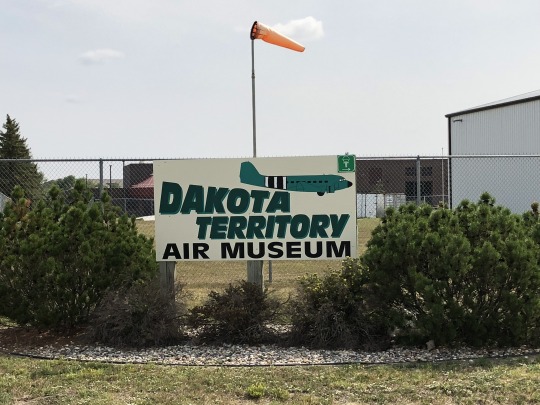

When we returned to the campground, Paul washed the truck and trailer.
19 Aug 2018 (Sun) – A vicious thunderstorm rolled through last night. It lasted for more than an hour. At times, there was so much heat lightning that it seemed like daytime - split occasionally by bolts of lightning.
We packed up and left Grand Forks at 9:45 a.m. The rain cleared out some of the haze and the skies were partly cloudy during our ride to Minot. We stopped in Rugby to get pictures at the geographical center of North America. The marker was next to a Mexican Restaurant so we bought lunch while there. They must make out like bandits because of the monument.
It was more than four hours to the Air Force Base. When we arrived, the Outdoor Rec office was closed. We pulled into an open campsite. There are six back-in sites in a parking lot with electric and water hookups. A dump station is down the road. There is a large playground in back of the parking area. Several prairie dogs holes dot that area.
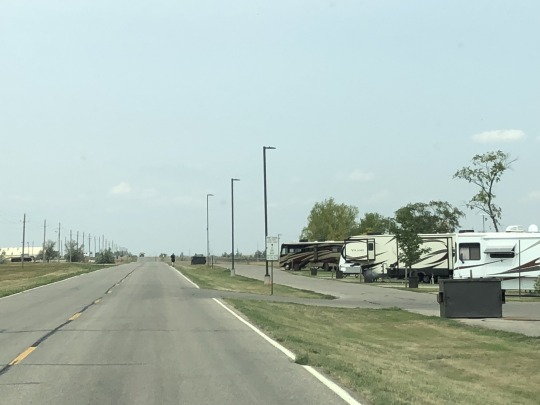
18 Aug 2018 (Sat) – We’ve been getting alerts about poor air quality. Fires in California, Idaho, Montana, and Canada are sending smoke and dirt particulates into the air. The sky has been hazy even though the weather service has been predicting sunny days.
We packed up and left Monticello at 9:50 a.m. Traffic was easy and we arrived in about two hours at Grand Forks AFB FamCamp. The campground reminds me of Fort Drum’s campground. It’s kind of remote and at the end of the base. There are only a few campers here. They have 61 campsites – 21 are full hookup and the rest are for tents (or boondocking). We have electric and water. We didn’t bother connecting the sewer since we are only here for one night. Paul chose a site right next to the bathhouse so we’re trying to use their toilet instead of ours.

Once set up, we drove about 25 minutes into the city of Grand Forks. It is a pretty old town with lots of historical buildings. We ate at the Rhombus Guys Brewing Company. The service was horrendous. There was a bridal shower going on but the place never called in extra help. It was almost an hour and a half before we got our food. People who came in after us got their food before us and we got our food before people who were seated before us. There didn’t seem to be any rhyme or reason as to how the kitchen was preparing the food. They were quick to jump in and serve another beer when Paul finished the first but other than that, the waitress barely came by the table. It was like she was avoiding us. Probably embarrassed about the long delay.
After lunch, we walked along the main street and riverwalk. A memorial tower had been erected in the park to commemorate five floods that have devastated the town. There were various high water marks on the tower, the highest point occurring in 1997. As a result, they built a dike system to hold back rising waters.

On the way back, we stopped at a department store called Home of Economy (weird name, right?). There were no coffee makers with thermal carafe so we drove to WalMart. There, we found a Black & Decker coffee maker just as we wanted. We bought it and returned to the campground then did our laundry on site.
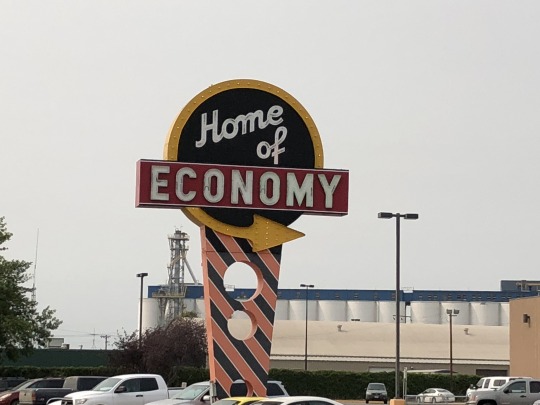
17 Aug 2018 (Fri) – We drove a half hour into Fargo to go to the Fargo Air Museum. It was small and contained within two hangars. There were about a dozen planes. A lot of the exhibits were devoted to aerobatic planes with a few military aircraft on display. Many uniforms and military paraphernalia were also on display. A B25 used by four governors was available for visitors to walk into and look around.
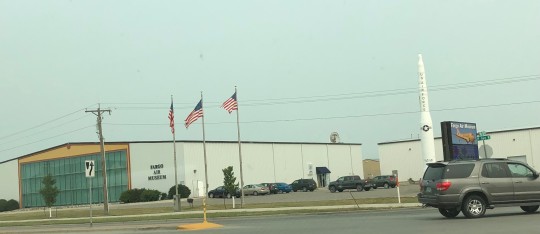
We left the museum and drove to the Border Town Bar & Grill for lunch. We enjoyed a taco lavosh. It was like a pizza but made with a cracker crust. It was good. The waitress had a chip on her shoulder and our service suffered for it. She was one of two girls serving tables and we guessed someone didn’t show up for work or she might have been directed to do something she didn’t like. Either way, she was certainly letting the patrons know she was not happy.
After lunch, we stopped at an RV dealer to look at some ice fishing trailers. We have seen many up north here and wanted to see what they looked like inside. They’re kind of cool. There are bunks and kitchens and bathrooms and sealed holes in the floor. One just had a toilet seat with a space underneath where you would put a bucket. Another had a regular toilet system with a dump valve. Some had heat, water, a microwave, and a refrigerator. All the holes in the floor each had a light directed at the hole. I guess so you could see into the hole when you fish. People have been using these “ice houses” as regular campers. We have spotted several in campgrounds.
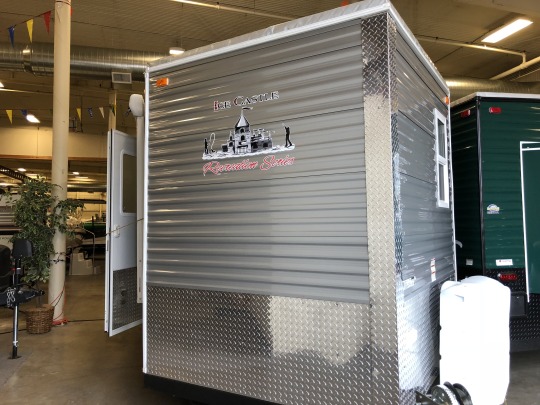
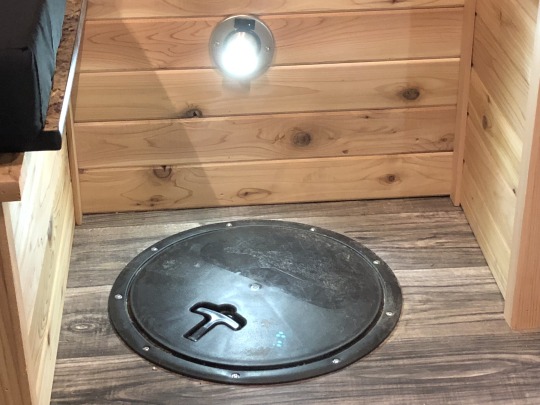

Next, we drove to Bonanzaville. It is a collection of historical buildings and artifacts dating back to settler days. It is called Bonanzaville because North Dakota used to be known for its Bonanza farms. There were small farms that were basically self-subsisting and then there were large farms that produced more than they needed. Those were called Bonanza farms. We strolled along the streets wandering in and out of the old buildings, admiring the exhibits on display. It was pretty large and took us a couple of hours to go through everything. A Telephone Museum showed the progression of telecommunications. Some kids were having fun playing with the phones. There were a couple of phones set up to call each other. You could dial a phone across the room, listen to the clicks and whirs of a switching station, hear the telephone ring, then talk to the person who picked up the phone at the other end. There was also an air museum, a car museum, and a kind of catchall museum with unusual items on display (a glove stretcher, a wooden fishhook from Alaska, pipes from Norwegian settlers, a square knife strop, a dress lifter for ladies crossing muddy streets, etc.). It was an interesting afternoon.

16 Aug 2018 (Thu) – We pulled up stakes and left Monticello, MN, at 9:20 a.m. It was 220 miles to Casselton, ND, about 20 miles west of Fargo. The hotel is a Days Inn but the adjacent campground is called Governors Drive RV Park. The sites are close and paved with gravel. We have a pull through with full hookups. There are about 40 campsites in the campground.

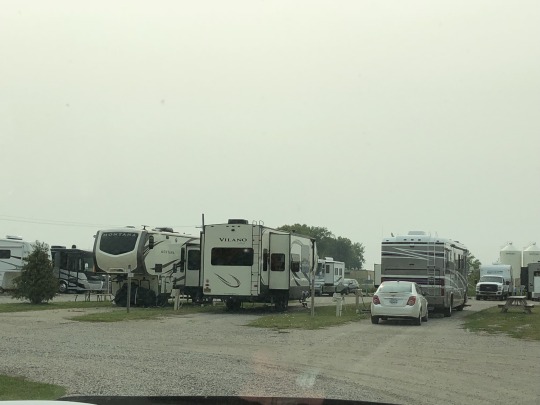
We stopped at a rest area around noon to make lunch. When we were finished with our sandwiches, we continued on to our destination. The weather was perfect and the traffic was mostly not a problem (we had a brief hold up for some construction on I-94). We checked in at the desk in the hotel and then got set up. Then we drove to Fargo to pick up some groceries. We also stopped in at the Information Center and got a map and other brochures about the state. There was a wood chipper with a fake leg in it for visitors to take pictures with. This is intended for those persons who watched the movie, Fargo. In the movie, a crook puts his unfortunate partner in the wood chipper. The sheriff comes along just as he’s pushing the last leg into the machine. The funny thing about it all is that the movie was not filmed in Fargo at all. It was filmed in a town up on the Canadian border and in Minnesota. The clerk recommended Kroll’s Diner for lunch. We went to the diner. It was a 50’s style diner with a counter on one side and booths on the other side. We had a cheese button (similar to a pierogi but four times the size and deep fried) and something unpronounceable. It was like a thin slice of meatloaf inside a pastry that was deep fried. After lunch, we picked up groceries at WalMart then returned to Casselton.

2 notes
·
View notes
Text
Massive Houston hemp facility has its eyes on a cannabis-infused future
A distinct aroma wafts through the offices of Bayou City Hemp, where the skunky smell of cannabis mixes with the sweet smell of optimism.
As one of the first and largest hemp processors in Texas, the two-year-old company is planting the seeds for a legal cannabis industry that the founders say will come. Until then, Bayou City will focus on clean forms of extracting cannabidiol – CBD – oils from the hemp plant and processing them into products such as edible gums, drinkable mixers and inhalable vape pens. Products it makes can help you fall asleep, relieve your pain, and even get you high.
Ben Meggs and Jeromy Sherman were friends and colleagues who worked in the oil and gas industry before founding Bayou City Hemp in 2019. The company aims to fill a void in the emerging Texan market – regulators legalized the industry in 2019 to help farmers squeezed by the U.S. trade war with China. When they started planting and harvesting, the farmers needed a place to process the raw hemp.
On HoustonChronicle.com: Hemp or marijuana? After a year in the dark, Harris County attorneys will finally know.
“We saw that the industry bottleneck would be on the processing side,” said Sherman. “We started the company that we couldn’t find.”
House Bill 1325, enacted two years ago, made it legal to manufacture, distribute, and sell consumable hemp products in Texas in an emerging industry that is now regulated by the Texas Department of State Health Services. The legislation followed the passage of the Federal Farming Act in December 2018, which redefined hemp as a low-THC cannabis product (0.3 percent or less THC) and removed it from the definition of marijuana in the Control Substances Act.
While hemp is legally different from its cousin marijuana in terms of its THC content – it’s the same type of cannabis plant – nature often doesn’t draw a clear line. If hemp has too high a THC content, federal agencies require that it be destroyed.
The legalization of hemp ushered in a new wave of production and ended a gray area in which trade had previously been active. Hemp is now used as an ingredient in everything from drink mixers to shampoos. Hemp Industry Daily magazine predicts US retail hemp sales will reach $ 3.9 billion this year, up from $ 1.6 billion last year. Retail sales are expected to reach nearly $ 6.3 billion in 2022.
But farmers have struggled to start harvesting in Texas, where the climate differs from that of the northern states from which they plant seeds.
Last summer’s harvest was the first in Texas, and since then Bayou City has processed hemp from half a dozen farmers and expected to add to that list to find better seed sourcing and growing in Texan conditions.
Bayou City hemp worker Cameron Gonzales uses the CO2 extractor to pull oil from the hemp plant in Houston on Thursday, June 24, 2021, exiting the oil and gas industry after the law passed and stepping into the growing CBD industry a.
Godofredo A. Vásquez, Houston Chronicle / Staff Photographer
Lift off the ground
Self-funded and with investments from friends and family (they didn’t want to say how much), Sherman and Meggs brought in Karen Trotter, who had previously worked as the company’s chief financial officer, financing oil and gas startups to make sure they if they had the capital they had to hit the ground under their feet. Today the company employs more than two dozen people, from chemists and plant operators to marketing and accounting professionals.
Partners started equipping their Park Row lab last summer and started seeing products in September. “We’re still in start mode,” said Trotter.
To this end, Bayou City is helping Texan farmers to source more successful seeds, advising them on cultivation, and helping them with tests, as well as with any extraction and processing.
“There’s no playbook for that,” said Sherman.
“It’s an industry that didn’t exist before,” said Meggs.
Texas hemp farmers have struggled to achieve full harvests as they cite poor seed genetics and problems with insects and mold. Hemp prices also collapsed in 2019 as farmers loudly demanded to plant the newly legal market crop and overproduction prevailed.
Texas Inc .: Get the best business news delivered to your inbox
“The floor fell out when we were ready to hit the market,” said Scott Meiers, co-owner and president of Texas Premium Hemp Producers in Brenham.
Meiers, a rancher, said he almost gave up on hemp last year because it was so difficult to grow and make a profit. His mind changed when he saw how CBD gums were helping his nephew, who was autistic and up to this point non-verbal.
“He came up to me, patted my shoulder and said, ‘Good job,’ while I was barbecuing,” recalls Meiers. “I cried. It really, really changed his life. “
When Meiers decided to try again, Bayou City Hemp helped him source his seeds better and provided him with hemp products that he could sell on the farm to make ends meet until he could sell his own hemp. Meiers said he expected to have his first harvest next month.
Calvin Trostle, an agronomist at Texas A&M, said in a recent university paper that the Texas hemp industry will take time to research and perfect. And costs have to fall so that it can take off as a yielding plant.
“As an alternative crop, the hemp industry in Texas is still in its infancy,” said Trostle. “There’s a lot of education going on, but we’re still trying to figure out which strains are adaptable so we can help producers avoid headaches.”
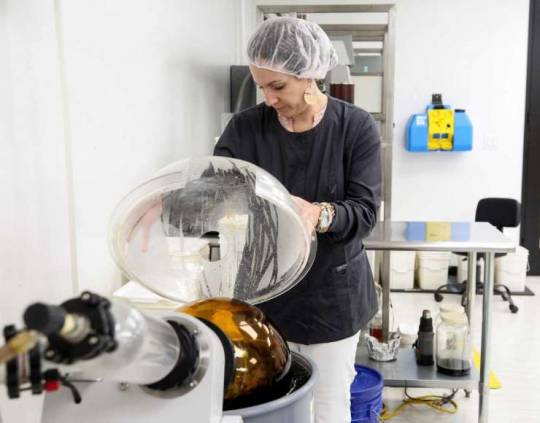
Karen Trotter, CFO of Bayou City Hemp, opens the rotary evaporator that makes winterized hemp extract extract during a tour of its facilities in Houston on Thursday, June 24, 2021. Bayou City Hemp is one of the largest hemp manufacturing outposts since Texas legalized hemp in 2019. After the law was passed, the founders left the oil and gas industry and entered the growing CBD industry.
Godofredo A. Vásquez, Houston Chronicle / Staff Photographer
The elevated road
When it came to building the lab, Sherman and Meggs said they went out of their way, equipped it to medical industry standards of good manufacturing practice, and created an internal system that scans and scans each batch of CBD oil tracked.
“We wanted to plan for FDA regulation,” said Sherman, who was recruiting an extraction specialist with 40 years experience at Dow Chemical as chief operating officer and a general manager with more than a decade of experience in cannabis extraction in other states.
Bayou City also decided to use a carbon dioxide process to make hemp oil cleaner from the plant. Less expensive ethanol-based methods used in industry result in hazardous waste, while carbon dioxide extraction leaves plant material with a high protein content that – yet to be investigated – could be used as fodder.
“Our COO uses it in his garden and he says his broccoli has never been bigger,” said Trotter.
Growing pains
The extraction of CBD oils from the hemp plant is a multi-step process. The first is to remove the stems from the hemp flower and put them through a grinder, which gives a fine powder. Then Bayou City staff heat it to activate the cannabinoids inside and prepare them for extraction.
Fats and waxes are separated in the laboratory, resulting in an oil that they then distill three times to increase potency and remove impurities, achieving a purity of around 80 percent. They prepare an isolate that is 99 percent pure in a reactor room.
For those who prefer some THC in their CBD, leave it in and refer to it as a full spectrum oil. For others, they remove it and label it as broad spectrum oil. Some want the cannabis-like effects, so they convert it into something called Delta-8-THC, an intoxicating molecule similar to the THC in marijuana, but with a different atomic structure.
On HoustonChronicle.com: The largest expansion of the medical marijuana program in Texas to date is advancing in the legislature
Kristen Nichols, editor of Hemp Industry Daily, said that Delta-8 appears to bind less easily to cannabinoid receptors in the brain, producing milder results than the type of THC that is federally illegal and only regulated by state cannabis laws.
Nichols said she initially viewed Delta-8 as “a cheap knock-off, a loophole that people are taking advantage of”.
“I’ve changed my mind since then,” she said. “There are people who want something in between.”
A full cannabis extraction would be a welcome hub for the business, Meggs said, since the product is cheaper to work with and they can sell it for about three times the amount of CBD. But first, Texas has to go its neighbors’ route and legalize it.
“We’re looking forward to this day,” said Meggs. “But at the moment we live in the CBD world.”
Twitter.com/amandadrane
The post Massive Houston hemp facility has its eyes on a cannabis-infused future first appeared on 1st News Link.
source https://1stnewslink.com/massive-houston-hemp-facility-has-its-eyes-on-a-cannabis-infused-future/
0 notes
Photo

#brandon mceachern#broccoli city founder#broccolicity brandon#brandon mceachern broccoli city broccolicity brandon#brandon mceachern insecure#broccoli city fest founder#brandon j mceachern#hector maceachern son#marcus allen broccolicity broccolicity founder
0 notes
Link
High design: Seth Rogen is bringing his cannabis home goods to the US Written by Jacqui Palumbo, CNN After summiting the stoner comedy genre with movies like “Pineapple Express” and “This is the End,” actor Seth Rogen and screenwriter-director Evan Goldberg have set their sights on the US cannabis market. On March 11, the duo will launch their cannabis lifestyle brand Houseplant, with home goods including ashtrays and lighters shipping across the country, and strains of cannabis available for delivery in California to start. Their co-founders include producers James Weaver and Alex McAtee — who are part of Rogen and Goldberg’s studio, Point Grey Pictures — as well as venture investor Michael Mohr, who is heading Houseplant as CEO. Seth Rogen and Evan Goldberg are bringing their cannabis lifestyle brand Houseplant to the US, around two years after it debuted in Canada. Credit: Courtesy of Houseplant “Our founders have a long history enjoying cannabis and believe it should be treated with the reverence it deserves,” said Mohr over email. “Through their film work, and the pride with which they speak about cannabis publicly, Seth and Evan have shown the world that not only does the potential exist to have a healthy relationship with cannabis, it is also very normal, and can have an amazingly positive impact on one’s life.” Following an initial debut in Canada in 2019, Houseplant enters the US market at a time when there is growing momentum to legalize cannabis across the country. This past November, Arizona, Montana, New Jersey and South Dakota joined 11 other states — as well as Washington DC — in approving its recreational use and sales, and New York’s Gov. Andrew Cuomo has signaled his intention to do the same. The legal cannabis industry is projected to be worth $41.5 billion by 2025. The ashtray set was designed by Rogen and features a rest for one’s smoking apparatus, a saucer to hold a lighter and a matching earthenware vase. Houseplant’s products are meant to be displayed in the home. Credit: Peter Novosel/Courtesy of Houseplant Despite its lucrative market potential, marijuana has yet to be legalized in all 50 states. Cannabis is still classified by the country’s Drug Enforcement Administration (DEA) as a Schedule I drug — with “the highest potential for abuse,” and “no currently accepted medical use.” And while it’s often asserted by advocates that cannabis is safer than alcohol consumption, a 2020 study showed that today’s increasingly potent strains are linked with a greater risk of addiction, anxiety and psychosis. THC’s cannabinoid cousin, CBD, has meanwhile soared in popularity thanks to its reputation for soothing stress and pain, but the Food and Drug Administration (FDA) has not yet made a call on its safety. High design Houseplant joins a growing number of cannabis brands using design to transform the image of smoking from a closed-door habit to an integral part of one’s lifestyle. “Houseplant was born out of our love and passion for cannabis, design and art,” Rogen said in a press statement. The first three home products available at launch will be an aluminum and leather lighter that doubles as an ashtray; a set of three vinyl records with music meant to enhance one’s high; and an earthenware ashtray set with a matching vase. The set was designed by Rogen, who lately has been sharing his new interest in pottery-making online. The block table lighter has a lid that can be used as an ashtray and a notch to hold a smoking device. Credit: Peter Novosel/Courtesy of Houseplant Over a decade ago, Goldberg’s script for the 2008 movie “Pineapple Express,” starring Rogen and James Franco, opined on the design and engineering potential of weed. That vision has been realized following states’ legalizations, as unmarked Ziploc bags and basic head shop supplies have shifted to increasingly personalized strains offered in glossy dispensaries. There have even been accolades for cannabis design through the advertising industry’s Clio Awards, which recognized Houseplant’s packaging in 2019. In the coffee-table book “High on Design” published last year, editor Anja Charbonneau of cannabis culture magazine Broccoli writes on the seismic shift seen over the past decade. “The creatives behind these efforts envisioned a weed culture…the same way one might approach coffee, wine, or other handcrafted goods in an accessible way,” she said. “They created objects meant to be seen and enjoyed, not hidden away.” The vinyl record set comes with three albums: “Sativa Session,” “Indica Session” and “Hybrid Session.” Credit: Peter Novosel/Courtesy of Houseplant Mohr echoes that sentiment. “Our design ethos is centered around the idea of bringing cannabis out from its various hiding places and instead proudly displaying it in one’s home,” he said. “We saw a void in the market for beautiful, thoughtfully designed objects for people who enjoy cannabis and saw an opportunity to create something special.” An equity gap As some move to elevate the industry, there are still striking racial and social disparities, as cannabis culture moves forward through patchwork legality in the United States. Last year, the American Civil Liberties Union released a report that revealed that Black people are still 3.6 more times as likely to be arrested for possession of marijuana than White people, despite both groups partaking at similar rates. In Colorado, Gov. Jared Polis signed an executive order in October of 2020 to pardon over 2,700 people convicted of possessing up to an ounce of marijuana, following in the footsteps of Canada. Yet Canada’s attempts to do so have been criticized for their lack of speed. According to the CBC, 257 pardons were granted in the first year. Houseplant will offer smoking-related home goods around the U.S. as well as marijuana delivery service in California. Credit: Peter Novosel/Courtesy of Houseplant And, in California, where Houseplant will put down its roots, The Guardian reported last year that Black entrepreneurs have been disadvantaged while establishing their cannabis businesses in Los Angeles’ highly saturated market. Many White business owners in the city have meanwhile thrived. Last April, the state announced a grant program of $30 million to support entrepreneurs from communities disproportionately impacted by the plant’s criminalization. “How do you get to come and make millions of dollars off of our misery?” said Lanaisha Edwards, a Black LA-based entrepreneur, told The Guardian. Edwards had applied for a cannabis license to open a store in the city but said she was rejected after a year of planning due to the proximity of an existing dispensary. “The war on drugs destroyed so many families. We should at least get to come out on the other end and create some wealth out of it. But it’s not gonna happen the way this is going,” she is quoted as saying. Rogen and Goldberg — who will undoubtedly enter the market with the additional advantage of being celebrities — appear to recognize these disparities, and have announced a forthcoming mentorship program for “underserved entrepreneurs” called InHouse. They also publicly support drug policy reform organizations. “Evan and I also recognize that our lifelong dream of starting a cannabis lifestyle brand like Houseplant comes with a commitment to changing the unjust and racist cannabis laws that still exist in today’s society,” Rogen said. “We understand our responsibility to help right those wrongs and are dedicated to creating a more diverse, equitable cannabis industry.” Source link Orbem News #Bringing #cannabis #Design #goods #high #home #Rogen #Seth
0 notes
Photo

Houseplant: Seth Rogen is bringing his cannabis home goods to the US Written by Jacqui Palumbo, CNNAfter summiting the stoner comedy genre with movies like "Pineapple Express" and "This is the End," actor Seth Rogen and screenwriter-director Evan Goldberg have set their sights on the US cannabis market. On March 11, the duo will launch their cannabis lifestyle brand Houseplant, with home goods including ashtrays and lighters shipping across the country, and strains of cannabis available for delivery in California to start. Their co-founders include producers James Weaver and Alex McAtee -- who are part of Rogen and Goldberg's studio, Point Grey Pictures -- as well as venture investor Michael Mohr, who is heading Houseplant as CEO.Seth Rogen and Evan Goldberg are bringing their cannabis lifestyle brand Houseplant to the US, around two years after it debuted in Canada. Credit: Courtesy of Houseplant"Our founders have a long history enjoying cannabis and believe it should be treated with the reverence it deserves," said Mohr over email. "Through their film work, and the pride with which they speak about cannabis publicly, Seth and Evan have shown the world that not only does the potential exist to have a healthy relationship with cannabis, it is also very normal, and can have an amazingly positive impact on one's life."Following an initial debut in Canada in 2019, Houseplant enters the US market at a time when there is growing momentum to legalize cannabis across the country. This past November, Arizona, Montana, New Jersey and South Dakota joined 11 other states -- as well as Washington DC -- in approving its recreational use and sales, and New York's Gov. Andrew Cuomo has signaled his intention to do the same. The legal cannabis industry is projected to be worth $41.5 billion by 2025.The ashtray set was designed by Rogen and features a rest for one's smoking apparatus, a saucer to hold a lighter and a matching earthenware vase. Houseplant's products are meant to be displayed in the home. Credit: Peter Novosel/Courtesy of HouseplantDespite its lucrative market potential, marijuana has yet to be legalized in all 50 states. Cannabis is still classified by the country's Drug Enforcement Administration (DEA) as a Schedule I drug -- with "the highest potential for abuse," and "no currently accepted medical use." And while it's often asserted by advocates that cannabis is safer than alcohol consumption, a 2020 study showed that today's increasingly potent strains are linked with a greater risk of addiction, anxiety and psychosis. THC's cannabinoid cousin, CBD, has meanwhile soared in popularity thanks to its reputation for soothing stress and pain, but the Food and Drug Administration (FDA) has not yet made a call on its safety.High designHouseplant joins a growing number of cannabis brands using design to transform the image of smoking from a closed-door habit to an integral part of one's lifestyle. "Houseplant was born out of our love and passion for cannabis, design and art," Rogen said in a press statement. The first three home products available at launch will be an aluminum and leather lighter that doubles as an ashtray; a set of three vinyl records with music meant to enhance one's high; and an earthenware ashtray set with a matching vase. The set was designed by Rogen, who lately has been sharing his new interest in pottery-making online.The block table lighter has a lid that can be used as an ashtray and a notch to hold a smoking device. Credit: Peter Novosel/Courtesy of HouseplantOver a decade ago, Goldberg's script for the 2008 movie "Pineapple Express," starring Rogen and James Franco, opined on the design and engineering potential of weed. That vision has been realized following states' legalizations, as unmarked Ziploc bags and basic head shop supplies have shifted to increasingly personalized strains offered in glossy dispensaries. There have even been accolades for cannabis design through the advertising industry's Clio Awards, which recognized Houseplant's packaging in 2019. In the coffee-table book "High on Design" published last year, editor Anja Charbonneau of cannabis culture magazine Broccoli writes on the seismic shift seen over the past decade. "The creatives behind these efforts envisioned a weed culture...the same way one might approach coffee, wine, or other handcrafted goods in an accessible way," she said. "They created objects meant to be seen and enjoyed, not hidden away."The vinyl record set comes with three albums: "Sativa Session," "Indica Session" and "Hybrid Session." Credit: Peter Novosel/Courtesy of HouseplantMohr echoes that sentiment. "Our design ethos is centered around the idea of bringing cannabis out from its various hiding places and instead proudly displaying it in one's home," he said. "We saw a void in the market for beautiful, thoughtfully designed objects for people who enjoy cannabis and saw an opportunity to create something special."An equity gapAs some move to elevate the industry, there are still striking racial and social disparities, as cannabis culture moves forward through patchwork legality in the United States. Last year, the American Civil Liberties Union released a report that revealed that Black people are still 3.6 more times as likely to be arrested for possession of marijuana than White people, despite both groups partaking at similar rates. In Colorado, Gov. Jared Polis signed an executive order in October of 2020 to pardon over 2,700 people convicted of possessing up to an ounce of marijuana, following in the footsteps of Canada. Yet Canada's attempts to do so have been criticized for their lack of speed. According to the CBC, 257 pardons were granted in the first year. Houseplant will offer smoking-related home goods around the U.S. as well as marijuana delivery service in California. Credit: Peter Novosel/Courtesy of HouseplantAnd, in California, where Houseplant will put down its roots, The Guardian reported last year that Black entrepreneurs have been disadvantaged while establishing their cannabis businesses in Los Angeles' highly saturated market. Many White business owners in the city have meanwhile thrived. Last April, the state announced a grant program of $30 million to support entrepreneurs from communities disproportionately impacted by the plant's criminalization."How do you get to come and make millions of dollars off of our misery?" said Lanaisha Edwards, a Black LA-based entrepreneur, told The Guardian. Edwards had applied for a cannabis license to open a store in the city but said she was rejected after a year of planning due to the proximity of an existing dispensary."The war on drugs destroyed so many families. We should at least get to come out on the other end and create some wealth out of it. But it's not gonna happen the way this is going," she is quoted as saying.Rogen and Goldberg -- who will undoubtedly enter the market with the additional advantage of being celebrities -- appear to recognize these disparities, and have announced a forthcoming mentorship program for "underserved entrepreneurs" called InHouse. They also publicly support drug policy reform organizations. "Evan and I also recognize that our lifelong dream of starting a cannabis lifestyle brand like Houseplant comes with a commitment to changing the unjust and racist cannabis laws that still exist in today's society," Rogen said. "We understand our responsibility to help right those wrongs and are dedicated to creating a more diverse, equitable cannabis industry." Read full article: https://expatimes.com/?p=18908&feed_id=36843
0 notes
Text
We Asked 12 Brewers: What Brewery Makes the Best Hazy IPAs?

Let’s get right to the juicy stuff.
We’re talking, of course, about hazy IPAs, which continue to keep beer lovers waiting and salivating in line (at least before the coronavirus pandemic), in hopes of securing the latest rare releases.
Interestingly, fans of hazy IPAs, also known as New England-style IPAs or simply NEIPAs, far more often find their admiration for breweries that specialize in these highly popular beers rather than for particular examples — this due to many being made in limited quantities, and without broad distribution. (No doubt, scarcity contributes to the NEIPA’s appeal.)
So, with that in mind, we asked the brewers themselves which craft breweries they believe have demonstrated great proficiency in the uniquely American beer style. Below, 12 beer producers from across the country opine on the best purveyor of hazy IPAs.
The Best Hazy IPA Breweries, Recommended by Brewers:
Tired Hands Brewing Company, Ardmore, Pa.
Other Half Brewing Company, Brooklyn
Great Notion Brewing, Portland, Ore.
Humble Sea Brewing Co., Santa Cruz, Calif.
Root + Branch Brewing, Copiague, N.Y.
Cellarmaker Brewing Co., San Francisco
Triple Crossing Beer, Richmond, Va.
The Alchemist Brewery, Stowe, Vt.
Hudson Valley Brewery, Beacon, N.Y.
Mountains Walking Brewery, Bozeman, Mont.
Hop Butcher for the World, Darien, Ill.
Keep reading for details about all the recommended bottles!
“Wow. What a loaded question. The first brewer or brewery that popped into my head was Jean Broillet and Tired Hands. I just like Jean’s approach to beer in general. Trends are changing so quickly, and everyone wants the next hype beer style, but I like to rely on breweries that I know will create a consistently good and balanced product regardless. With hazy IPAs, so many examples are pushed out too quickly and get spicy. But I can have an IPA, or any beer, from Tired Hands weeks, even months, later, and they taste the same. (Full attenuation is key!) I’ve never been disappointed in a hazy IPA, or a pilsner, or an experimental potato something from Jean, and I don’t imagine I will be anytime soon.” — Erika Tessier, Co-owner and Assistant Brewer, Origin Beer Project, Cranston, R.I.
“I’ve been a big fan of Other Half, and the brewery’s IPAs are some of the best in the game, the continuous hype well deserved. They carry explosive aroma, mouthfeel, and flavor profile that checks all the right boxes. DDH Broccoli is still one of my all-time favorite IPAs, and the All Together initiative was not only a great beer, but a great campaign to support all these small business and communities during the coronavirus pandemic. The only downside is that I don’t have the opportunity to drink Other Half here in rural Iowa as often as I’d like!” — Eric Hild, Lead Brewer, Toppling Goliath Brewing Co., Decorah, Iowa
“Great Notion was the first brewer in Portland to start making hazy IPAs, and now there’s not one producer who doesn’t include at least one example in their lineup. What’s great about the city’s brewing community is that we openly share ideas; we’ve learned a lot about this style from each other. The most impressive part of Great Notion’s hazy IPAs is consistency. In particular, the all-Citra Ripe represents the style well, showcasing a silky body, balanced malt, and juicy hop expression.” — Shaun Kalis, Co-founder, Ruse Brewing Company, Portland, Ore.
“My choice for the best hazy IPA brewery isn’t from New England, but from a kooky town by the Pacific. I’ve been stoked on Humble Sea for a while and will always stop for a ‘Foggy’ IPA when in Santa Cruz. The brewery has been cranking out a ton of sick hazies since opening a few years ago, each more radical than the last. I think the Humble Sea team really nailed it with Socks & Sandals. Classic West Coast aromatics and flavor with that soft, creamy mouthfeel of a NEIPA; it really hit that sweet spot for me. It’s like East Coast meets West (Best) Coast.” — Justin Carter, Cellar Lead, Drake’s Brewing Co., San Leandro, Calif.
“Anthony Sorice of Root + Branch is one of a small handful of brewers that can really make a hazy IPA shine. His beers are well thought out, meticulous, and patiently executed. Root + Branch does a great job of keeping the style well balanced. Examples are bright, clean, and show the right amount of restraint, which is very rare these days. I had the pleasure to work alongside Anthony for a period of time and it was clear from the start that he had an excellent grasp on what makes a New England-style IPA work. There’s a very good reason why his beers sell out so fast, and it’s not just hype. The care, quality, and love is obvious.” — Stjepan Pavich, Lead Brewer, Other Half Brewing, Brooklyn
“Tim Sciascia at Cellarmaker makes amazingly crushable hazy IPAs that are consistently imbued with aromatic notes of Citra hops and tropical fruit. This adds to the drinkability of his beers, and shows off his amazing ability to find and select the best hops out in the market.” — Brian Rauso, Co-founder and CEO, Green Cheek Beer Co., Orange, Calif.
“Anytime I have a Triple Crossing hazy IPA, I end up staring at the glass after each sip. I’m half wondering how the Virginia brewery did it, and half hoping the consumed beer will magically replenish itself. That ‘it’ is being able to layer expressive yeast character, water chemistry, and hop aromatics in a way that makes its hazy IPAs truly stand out from the crowd. The single-hop Triangles series really showcases Triple Crossing’s chops; with only a single hop variety, the team achieves an envying amount of structure and complexity. Simcoe Triangles was the last one I had. It’s fresh-cut grapefruit bliss, summertime melon, and dank citrus wrapped up in a velvety smooth mouthfeel.” — Turner Humphries, Head Brewer, Hoptown Brewing Company, Mooresville, N.C.
“In my opinion, The Alchemist is one of the best producers of hazy IPAs. Everything the brewery makes in the style is nicely balanced in terms of aromatics and bitterness, and it’s based in Vermont, which has excellent water sources. Some of my personal favorite IPAs are Heady Topper and Focal Banger. Heady is probably Alchemist’s most famous beer. However, Focal Banger to me seems to be a more dialed-in recipe. I’m more of a malt gal myself, and I enjoy its malt sweetness. Not only does John Kimmich and team produce delicious hazy bois, but they’re also involved in community outreach, aspiring to educate and involve the community around them. The most recent involvement is an anti-racism action plan.” — Haley Ann Warren, Head Brewer, Sparge Brewing, Wellington, Colo.
“Hudson Valley Brewery consistently puts out great, more straightforward hazy, hoppy beer that flies under the radar because of all the attention — and rightly so — its innovative sour IPAs get. Though not an IPA, the hazy pale ale Diadem was one of the best hoppy beers I’ve had this year. The thing that excites me the most about what the Hudson Valley crew does, and where they seem to consistently differentiate themselves, is in blending capabilities. Their ability to skillfully arrange different fermentation profiles can really take hazy, hoppy beers to a place that is perfect for the modern drinker’s flavor and aroma wheelhouse.” — Ben Clayton, Founder and Brewer, The Test Brewery, Brooklyn
“The funky folks at Mountains Walking are making my go-to hazy IPAs these days, in particular the rotating Oat Whip series, which feature single hop varieties without changing the notion of a cloudy, juicy, hoppy beer. They make great companions at the end of a long trail hike or sitting on the side of a stream after a day of fly fishing. We were one of the first to produce hazy IPAs in the wilderness state, and we called them ‘frontier style’ because no one here really knew what a New England IPA was at that time. So we made up that term, since I had brewed in New Mexico and Pennsylvania prior to coming to Montana, where hazy IPAs had been around a lot longer. I’m glad to see other breweries taking the reins on this category that shines brightest on the local level, and making cloudy suds regularly available in Montana.” — Luke Steadman, Brewmaster and Janitor, Smelter City Brewing, Anaconda, Mont.
“I’ve always loved Other Half’s hazy IPAs. Along with a few others, Other Half paved the way for the style. The team is always pushing boundaries and I appreciate that. Right now, I’m really digging the brewery’s double dry-hopped session IPA, [DDH] Baby Diamonds. I love how well Amarillo and Galaxy play together, and it’s easy drinking.” — Maria Cabre, Head Brewer, J. Wakefield Brewing, Miami
“Hop Butcher is knocking it out of the park with the hazy IPAs right now. No two are alike, but they’re consistent with quality, pleasing mouthfeel, and exploding with flavor. The extensive range of hop profiles is incredible. A few of my favorites are Tavern Cut, Neon Green Relish, and Blazed Orange. I’m always excited to see what the brewery is going to put out next.” — Rachel Leiby, Head Brewer, Geneseo Brewing Co., Geneseo, Ill.
The article We Asked 12 Brewers: What Brewery Makes the Best Hazy IPAs? appeared first on VinePair.
Via https://vinepair.com/articles/12-best-hazy-ipa-beer-2020/
source https://vinology1.weebly.com/blog/we-asked-12-brewers-what-brewery-makes-the-best-hazy-ipas
0 notes